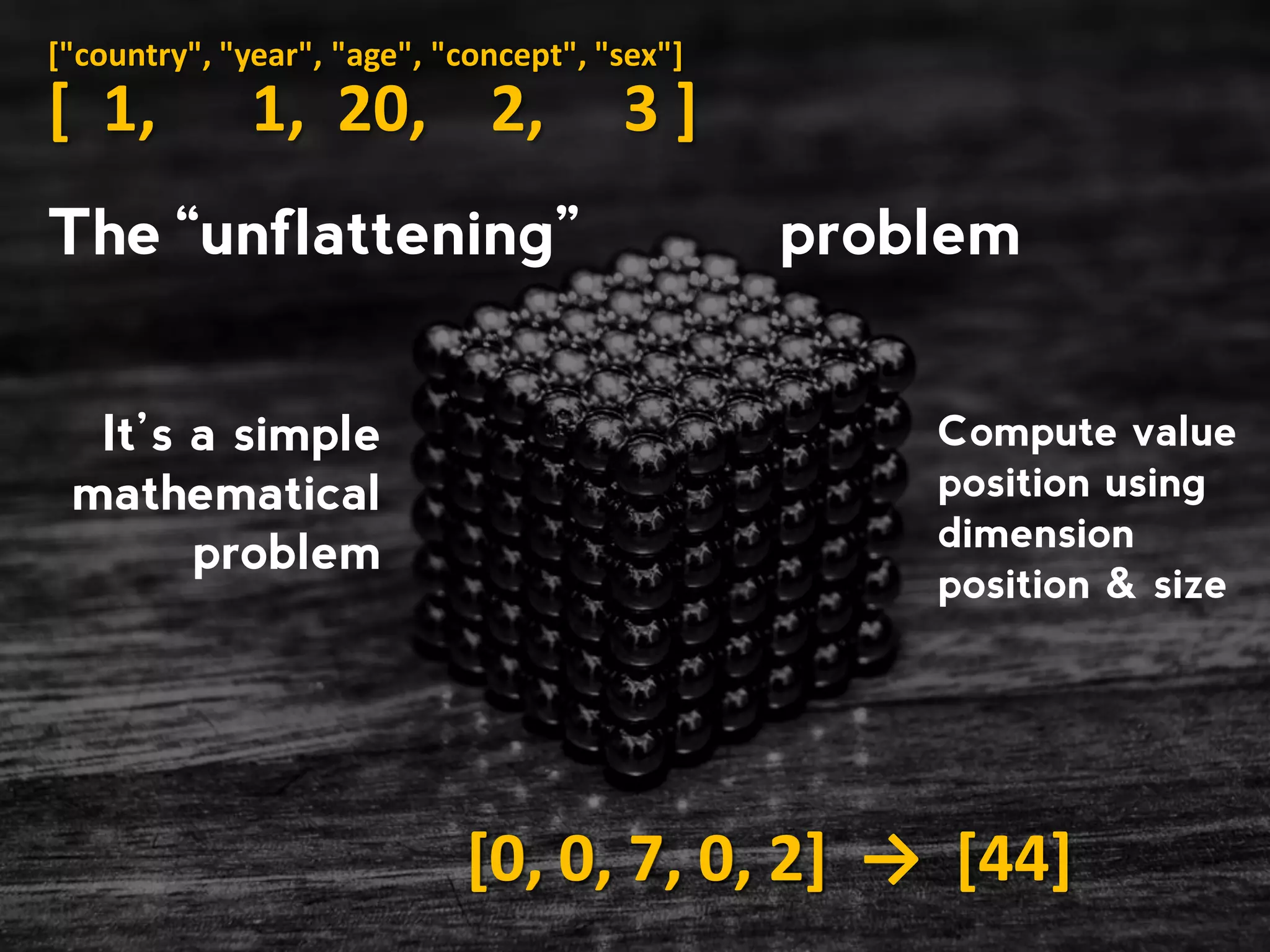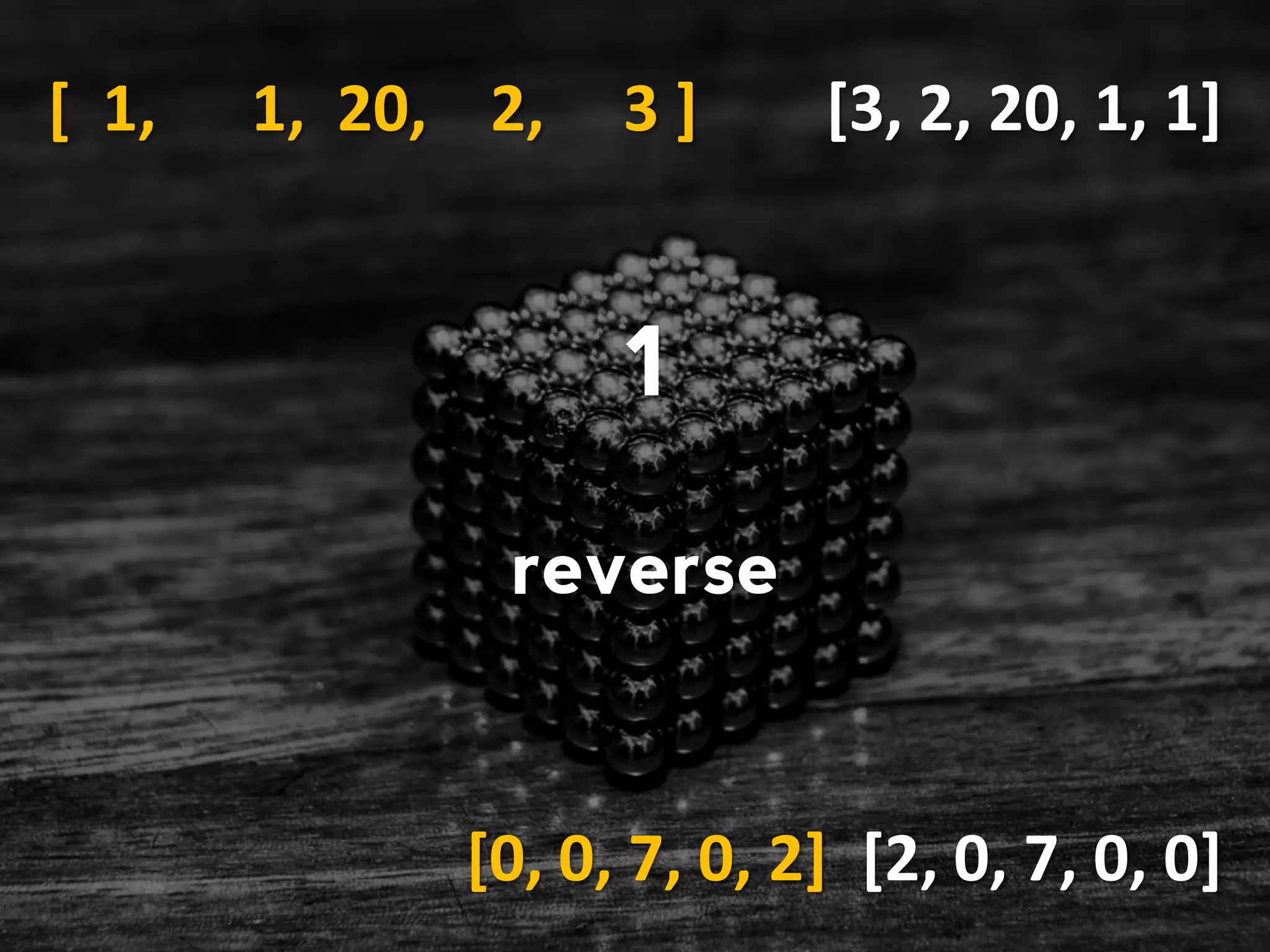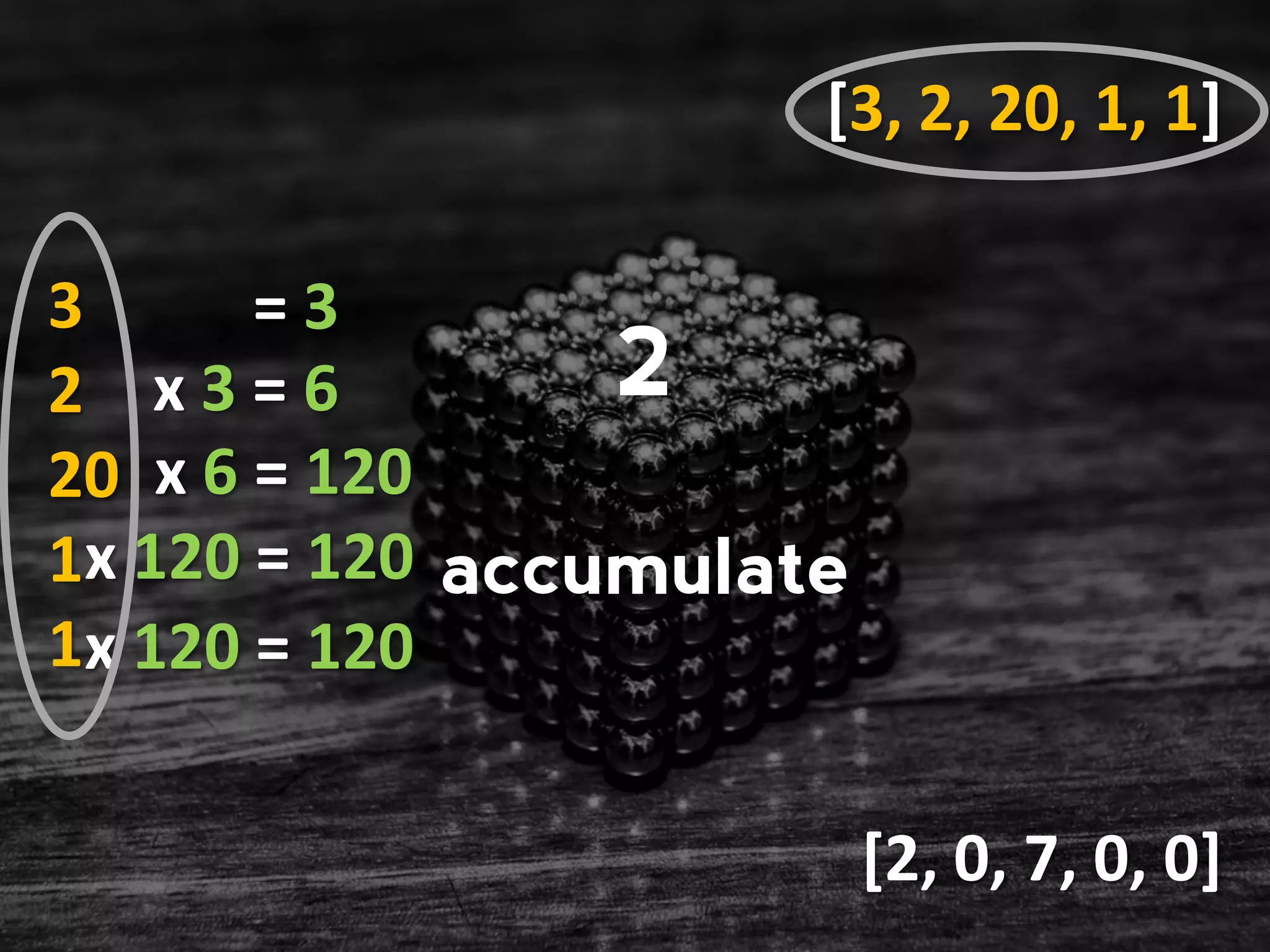The document outlines the JSON-stat standard for disseminating data efficiently, which is designed for various stakeholders like national statistical offices and organizations. It emphasizes the use of JSON format to integrate data and metadata, presenting data in a cube model that simplifies usage for both humans and machines. The document also addresses challenges related to data structure and provides methods for organizing multidimensional data effectively.


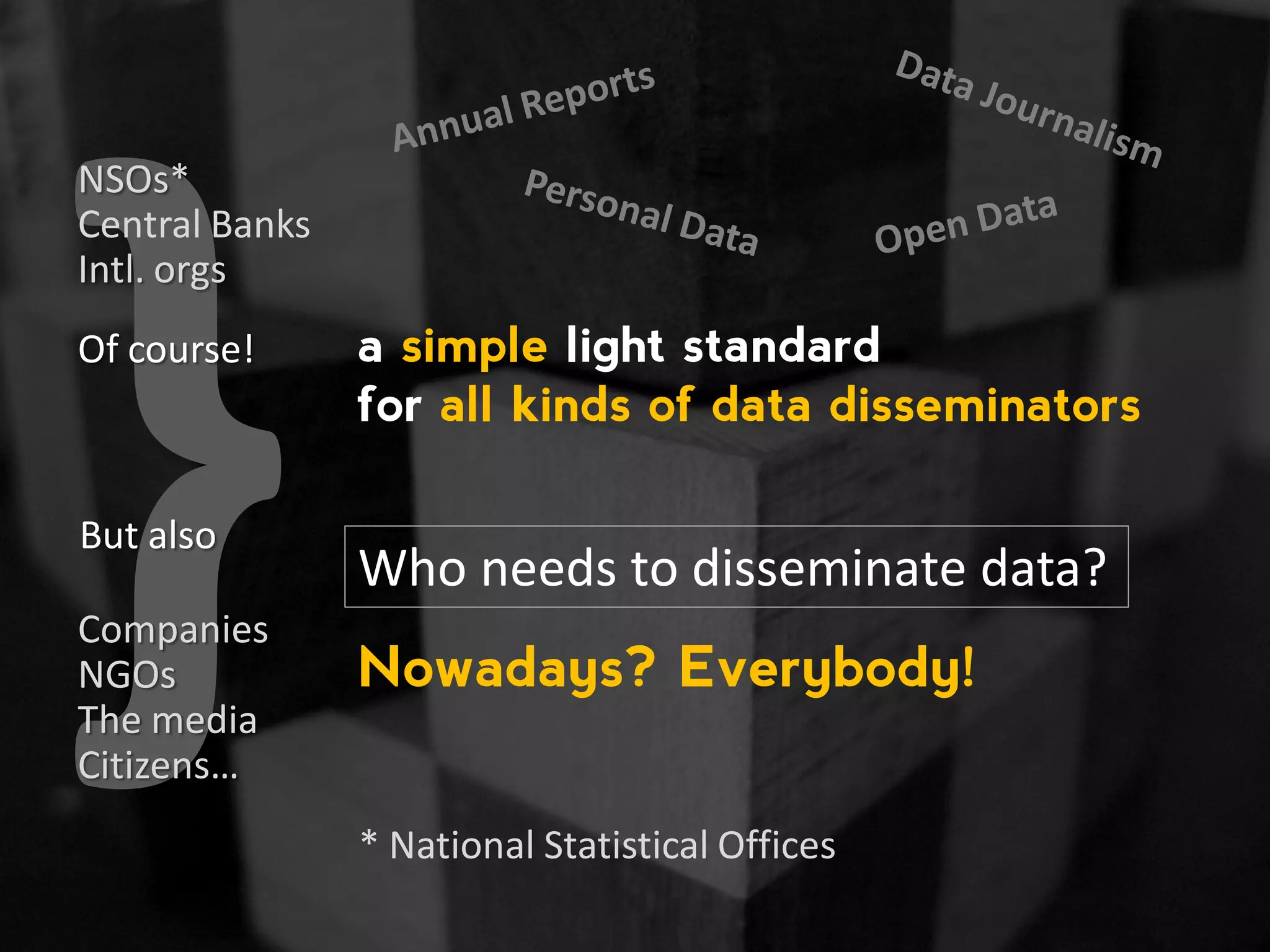
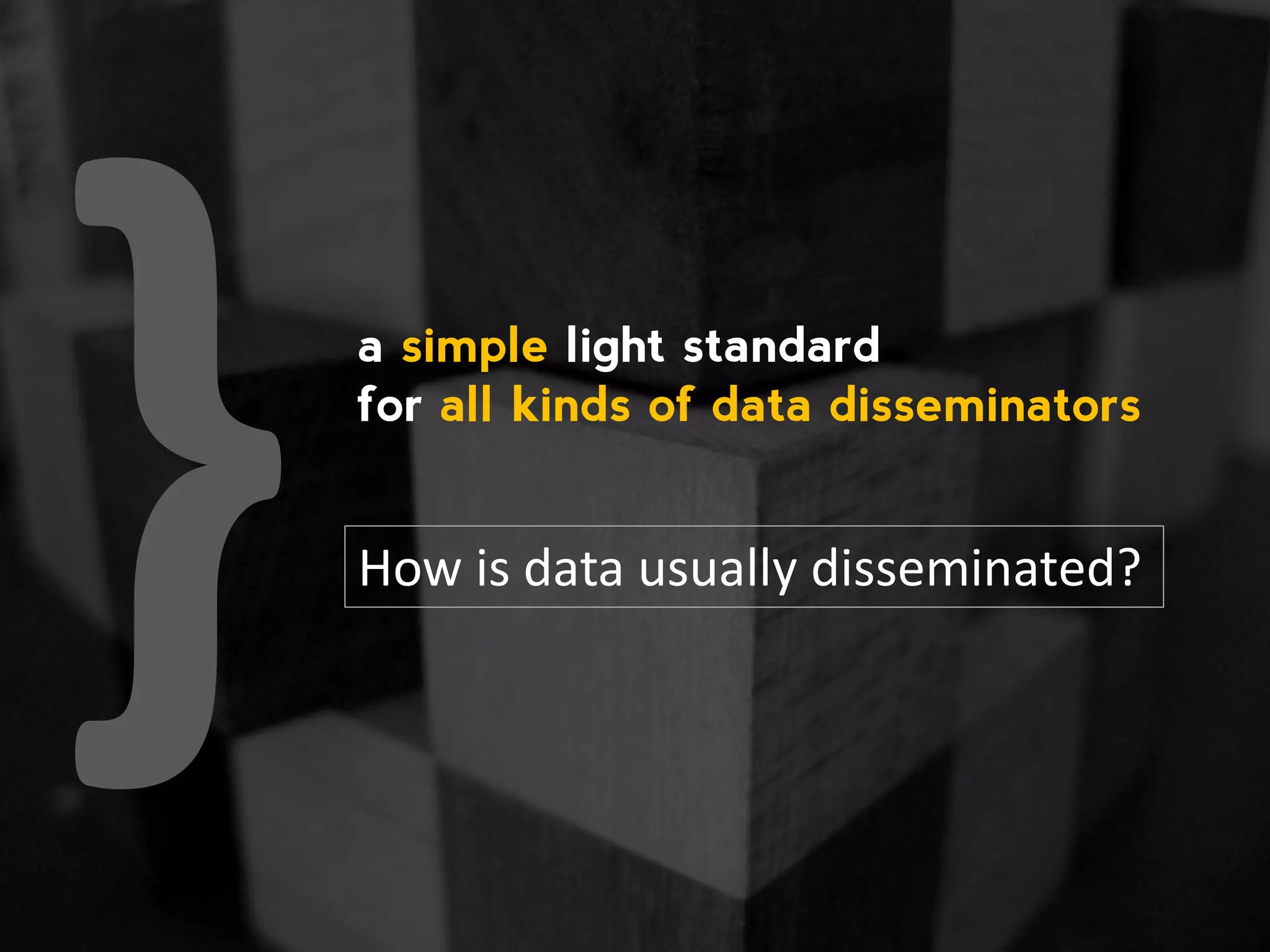
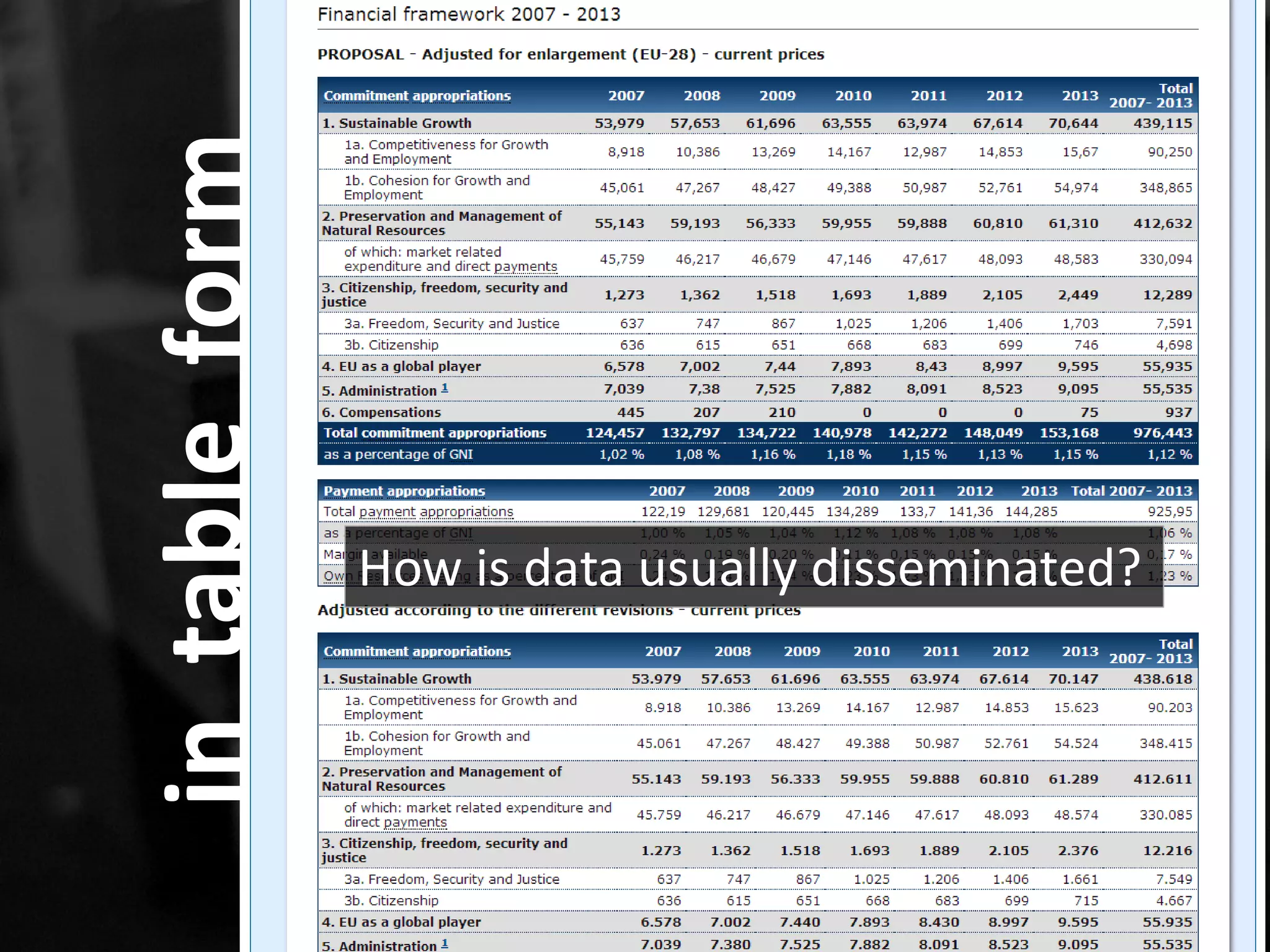
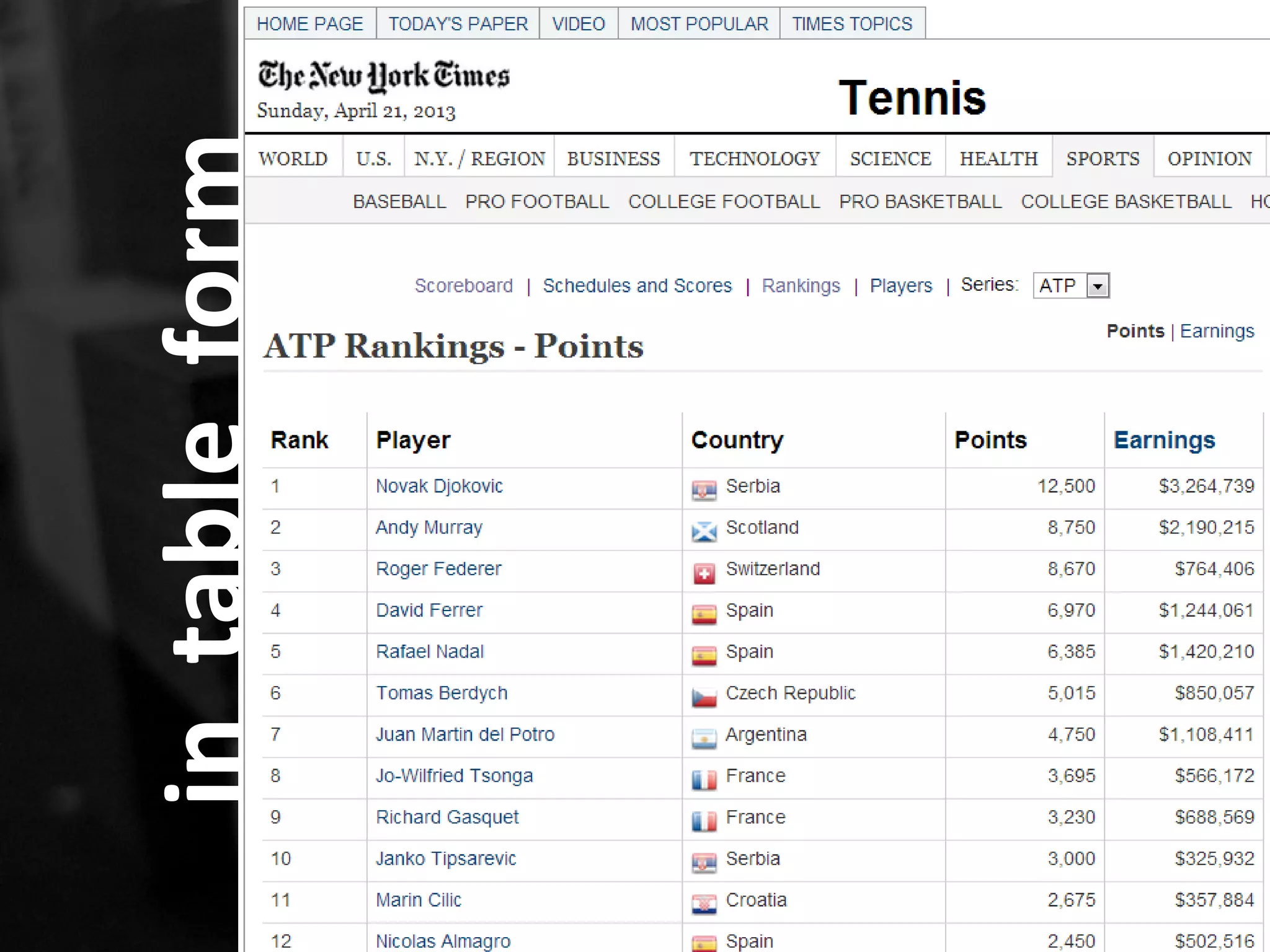
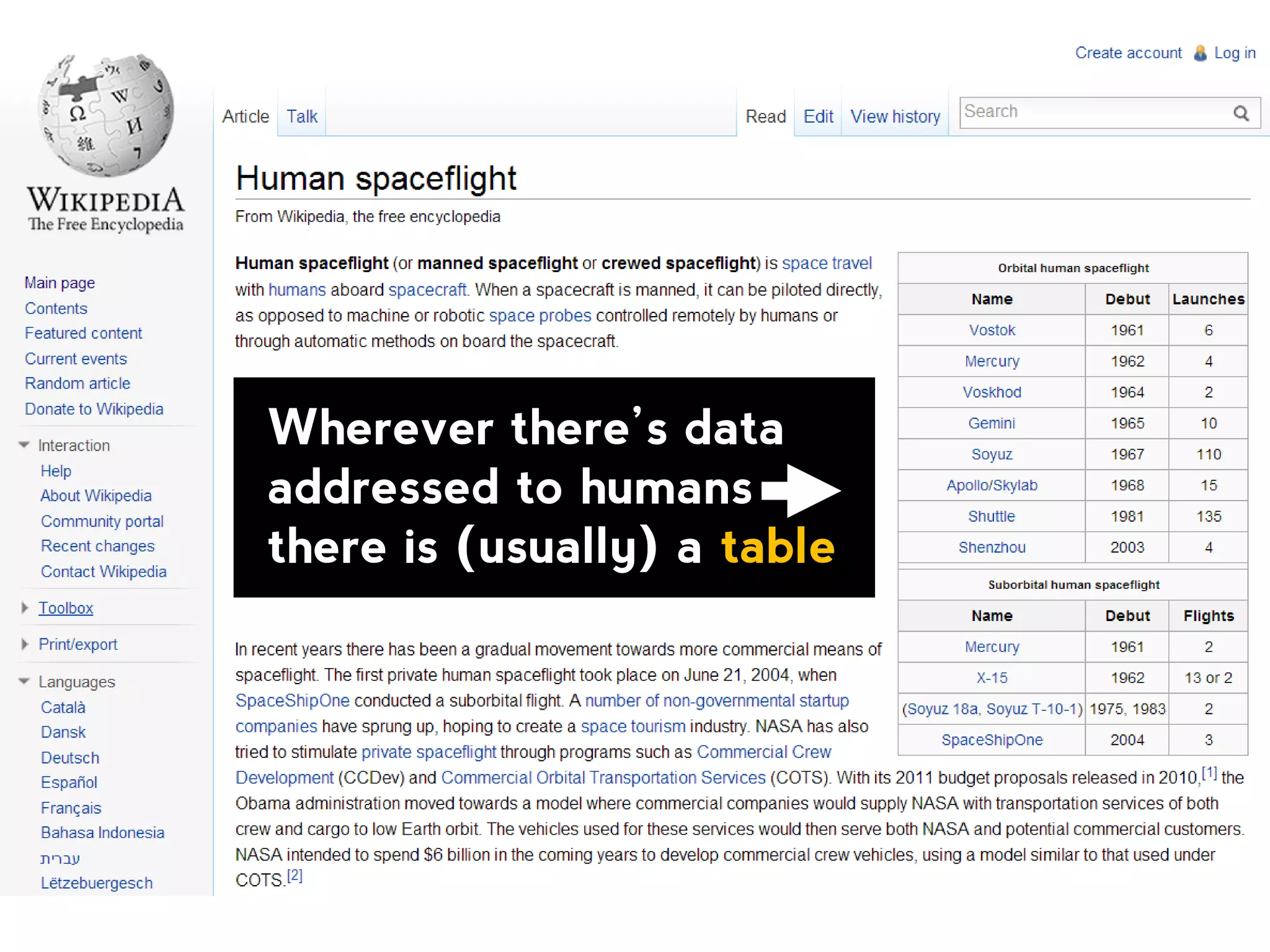
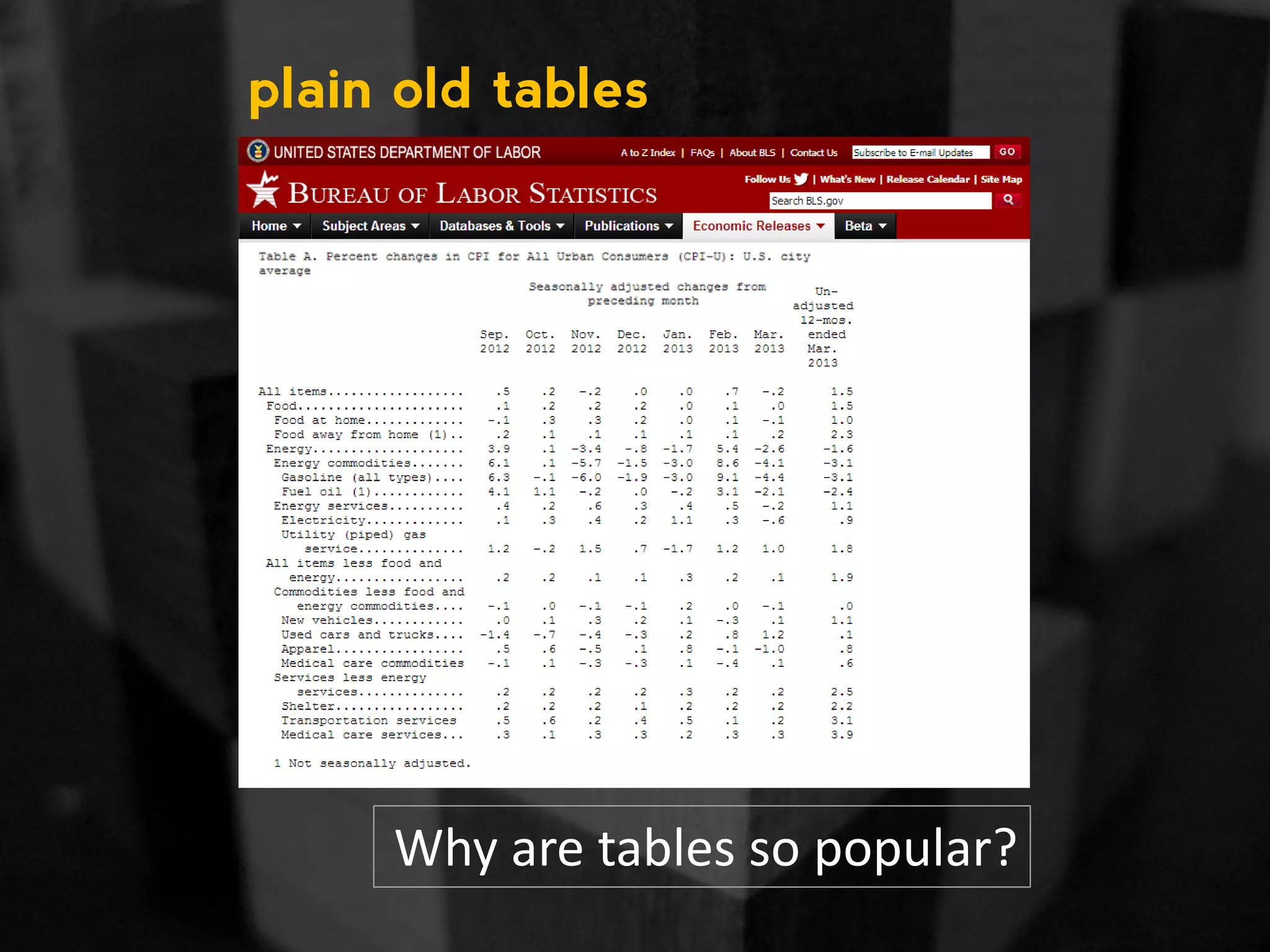
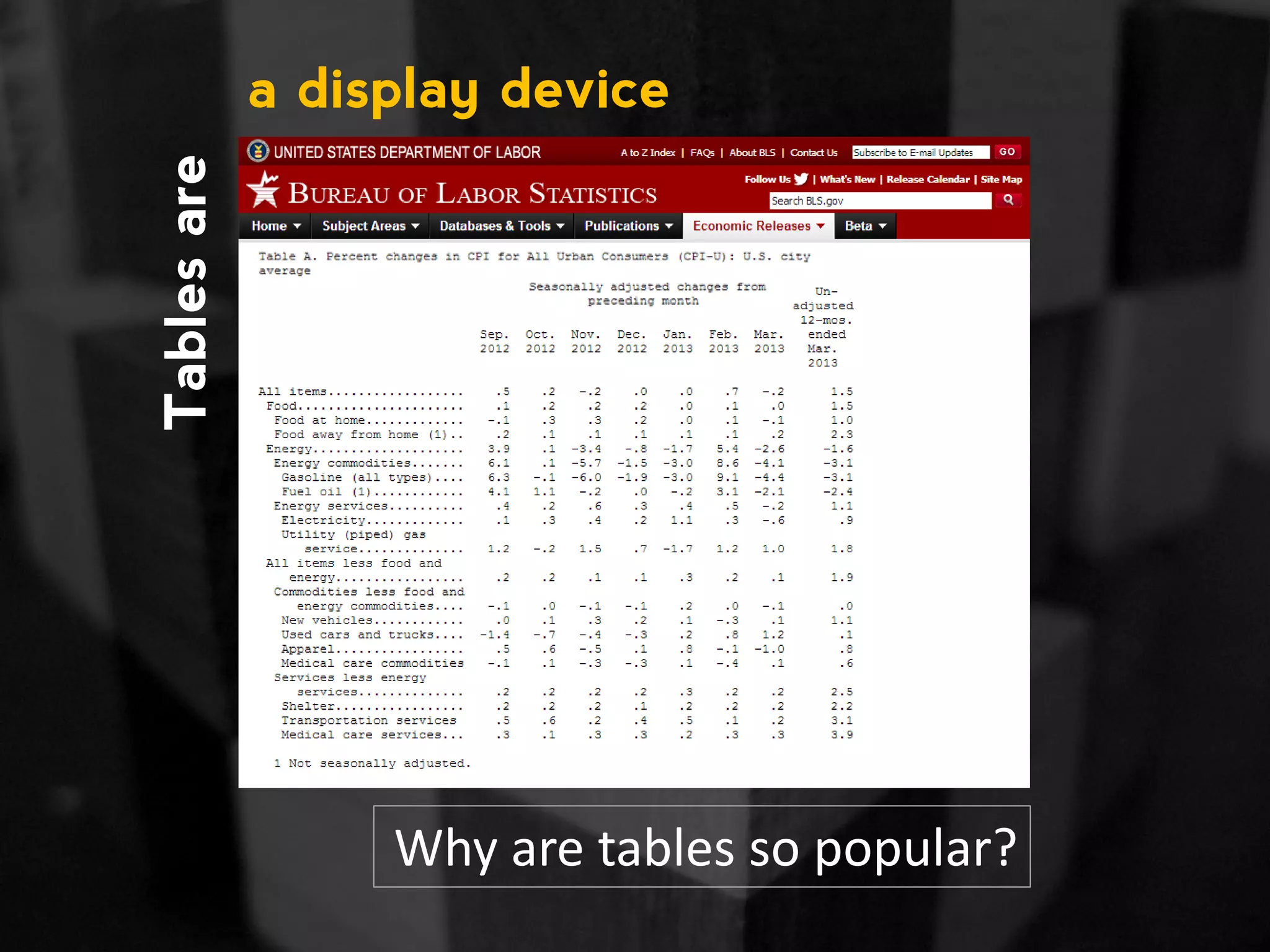
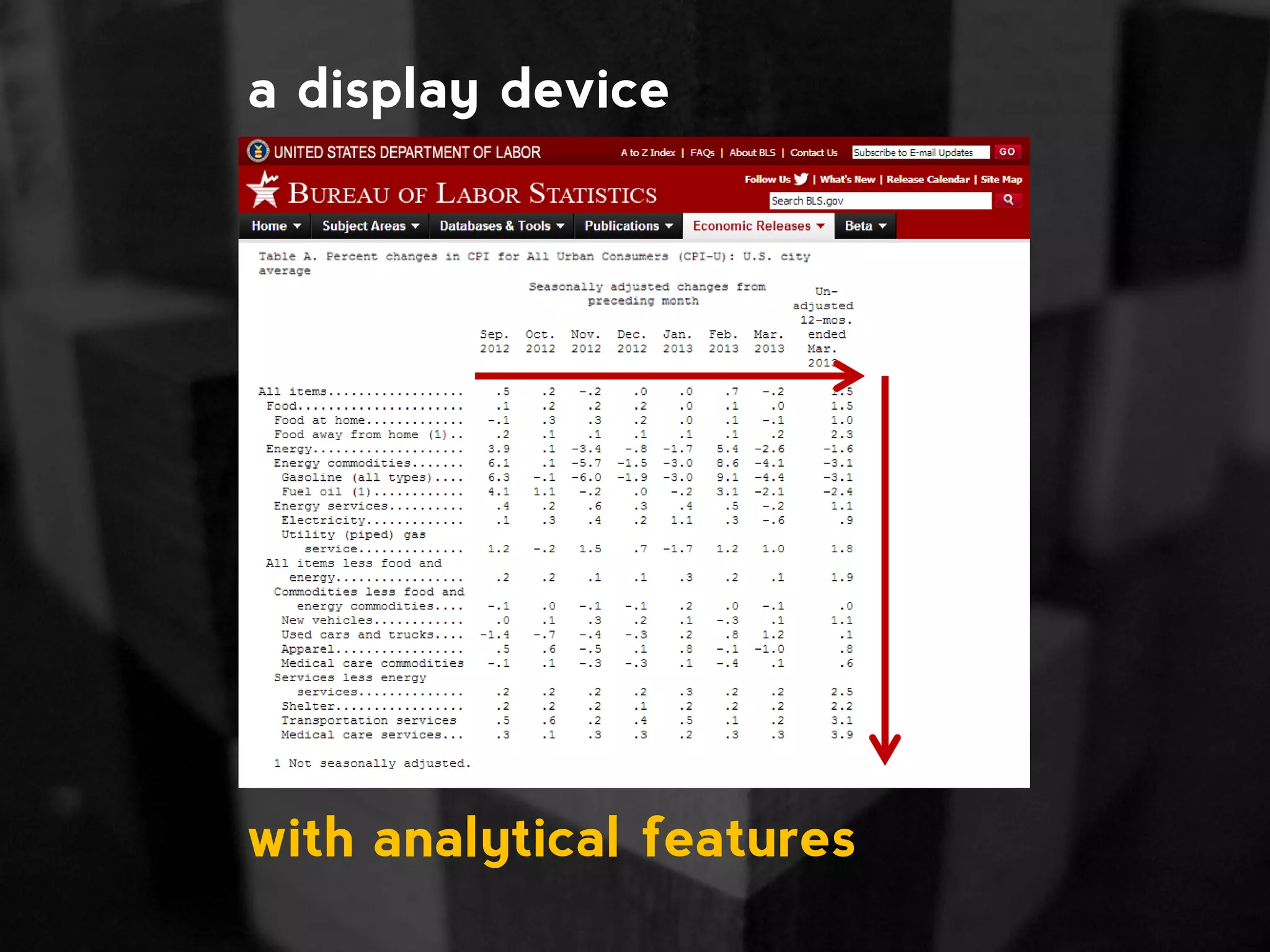
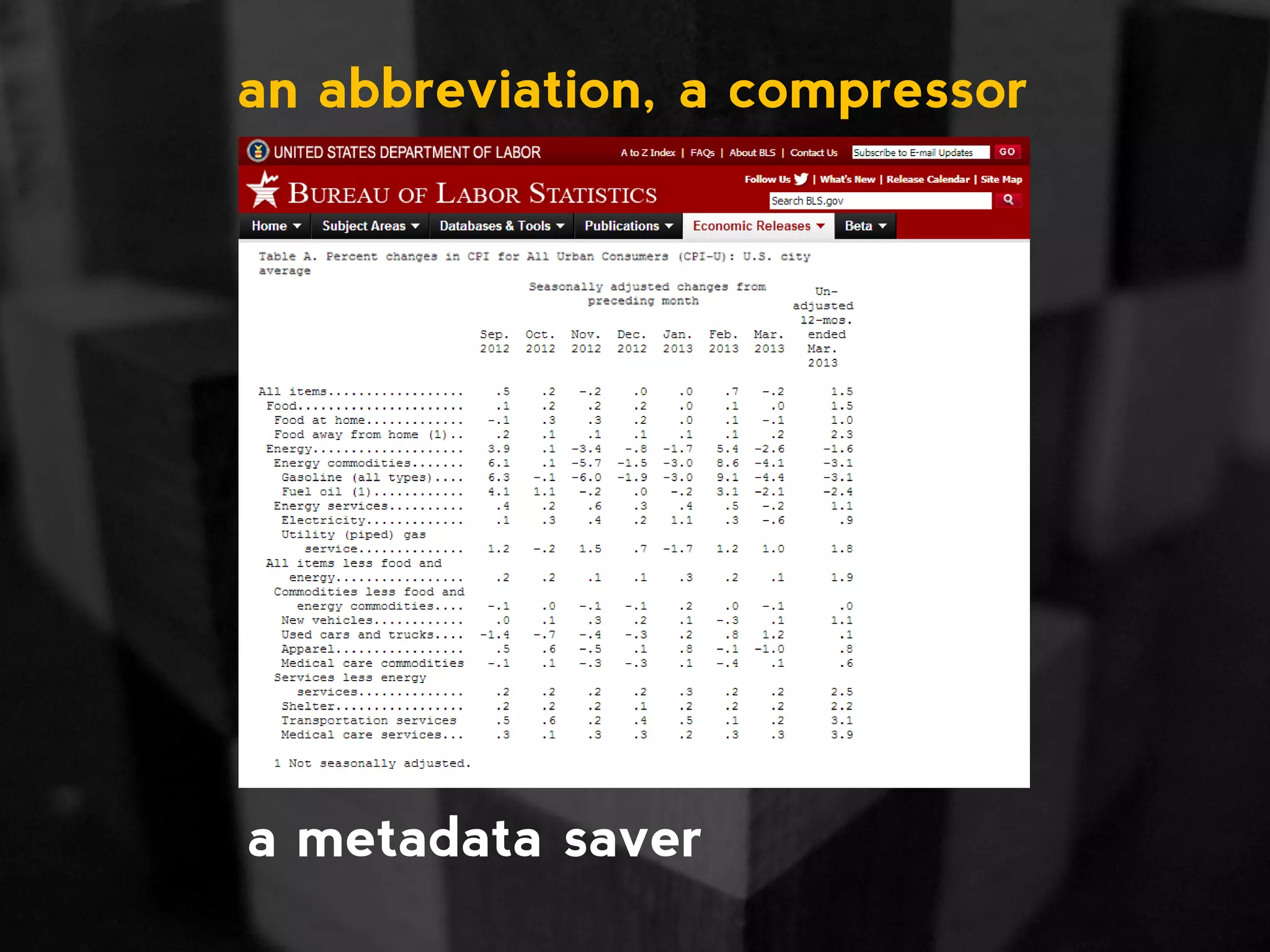
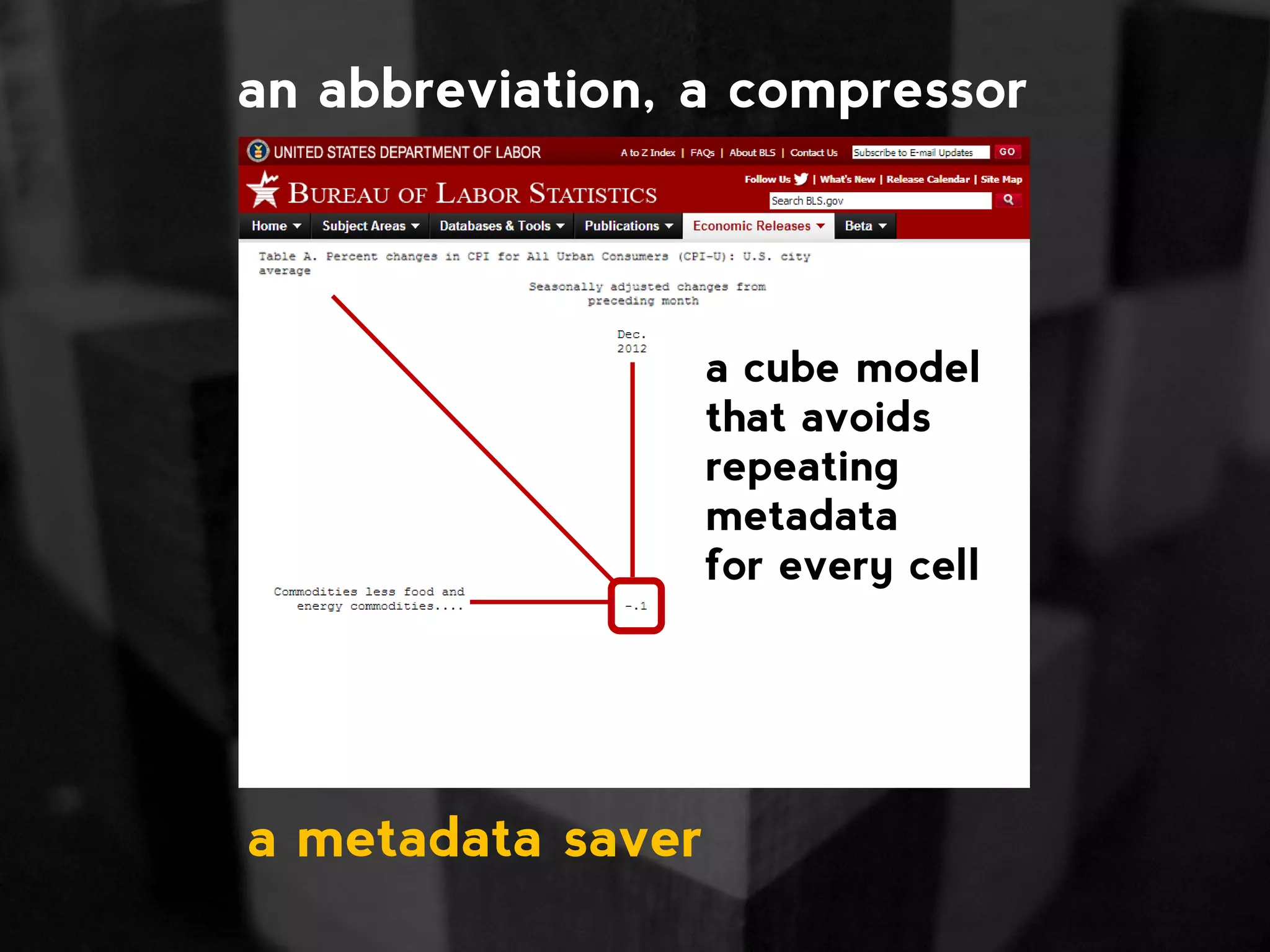




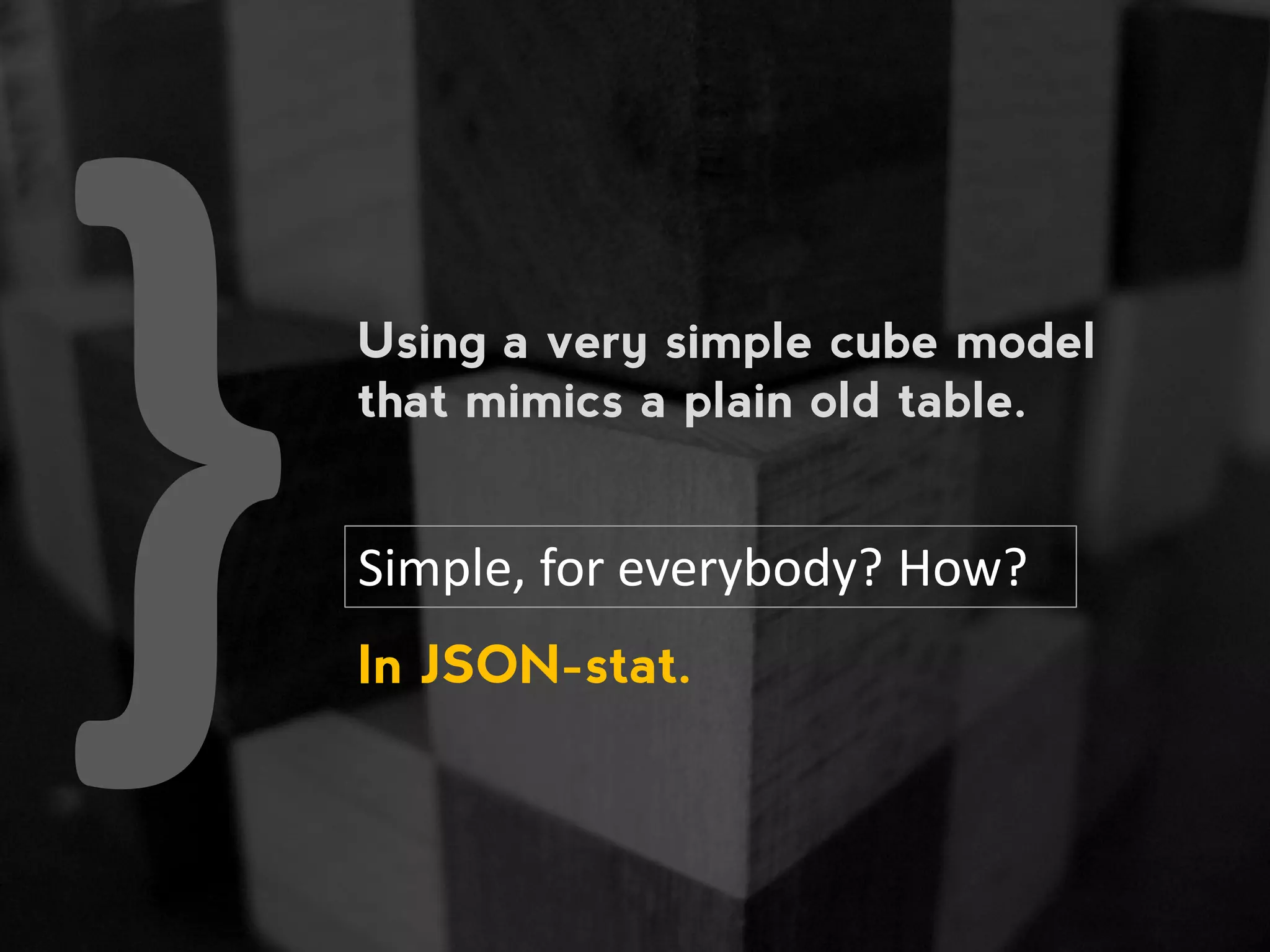
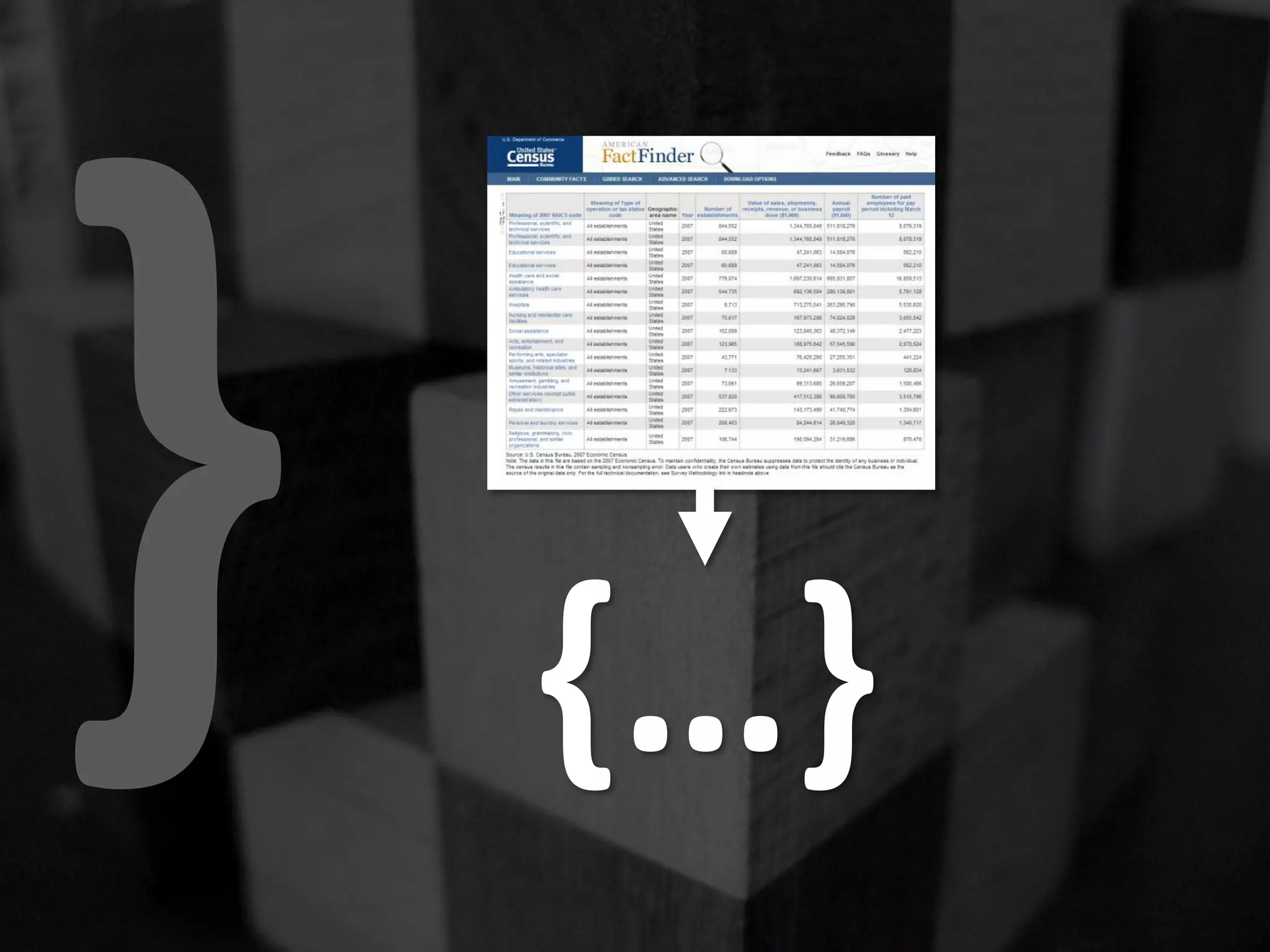


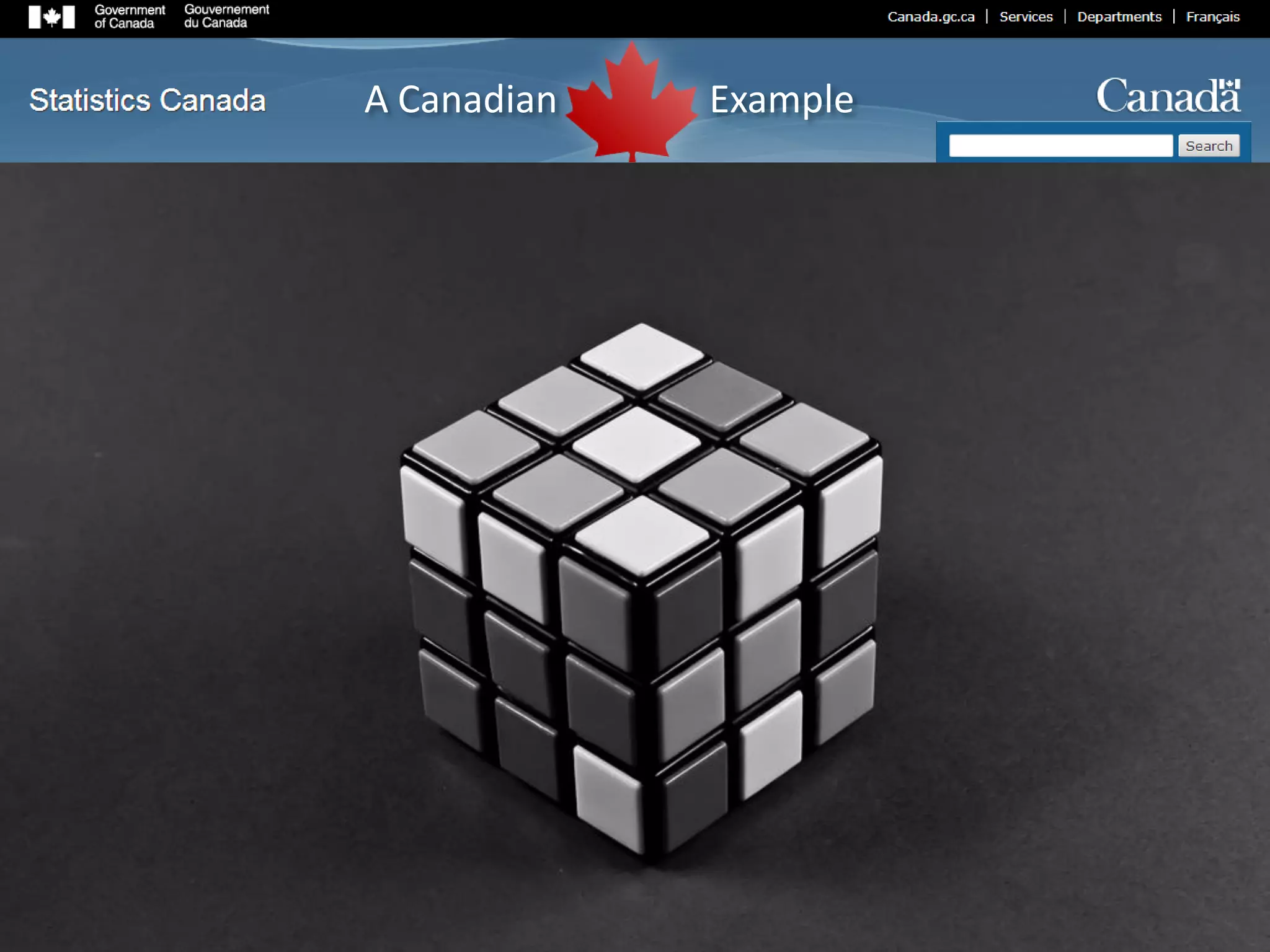
![[ ] , , , , , , , , , , , , , , , , , , , , , , , , , , , , , , , , , , , , , , , , , , , , , , , , , , , , , , , , , , , , , , , , , , , , , , , , , , , , , , , , , , , , , , , , , , , , , , , , , , , , , , , , , , , , , , , , , , , , , , , anarray (flat) What’s the simplest way to express these data in JSON?](https://image.slidesharecdn.com/json-stat-130712002843-phpapp02/75/JSON-stat-a-simple-light-standard-for-all-kinds-of-data-disseminators-22-2048.jpg)
![[ ] , , , , , , , , , , , , , , , , , , , , , , , , , , , , , , , , , , , , , , , , , , , , , , , , , , , , , , , , , , , , , , , , , , , , , , , , , , , , , , , , , , , , , , , , , , , , , , , , , , , , , , , , , , , , , , , , , , , , , , , Basic metadata?](https://image.slidesharecdn.com/json-stat-130712002843-phpapp02/75/JSON-stat-a-simple-light-standard-for-all-kinds-of-data-disseminators-23-2048.jpg)
![[ ] , , , , , , , , , , , , , , , , , , , , , , , , , , , , , , , , , , , , , , , , , , , , , , , , , , , , , , , , , , , , , , , , , , , , , , , , , , , , , , , , , , , , , , , , , , , , , , , , , , , , , , , , , , , , , , , , , , , , , , , "value" : "class" : "dataset", "label" : "Population by sex and age group. Canada. 2012", "source" : "Statistics Canada, CANSIM, table 051-0001", "updated" : "2012-09-27", } {](https://image.slidesharecdn.com/json-stat-130712002843-phpapp02/75/JSON-stat-a-simple-light-standard-for-all-kinds-of-data-disseminators-24-2048.jpg)
![[ ] , , , , , , , , , , , , , , , , , , , , , , , , , , , , , , , , , , , , , , , , , , , , , , , , , , , , , , , , , , , , , , , , , , , , , , , , , , , , , , , , , , , , , , , , , , , , , , , , , , , , , , , , , , , , , , , , , , , , , , , , "value" : } { "id" : [ "country" , "year" , "age" , "concept" , "sex" ], "size" : [ 1 , 1 , 20 , 2 , 3 ], "class" : "dataset", "label" : "Population by sex and age group. Canada. 2012", "source" : "Statistics Canada, CANSIM, table 051-0001", "updated" : "2012-09-27", "dimension" : { … } id and size are needed to “unflatten” the value array.](https://image.slidesharecdn.com/json-stat-130712002843-phpapp02/75/JSON-stat-a-simple-light-standard-for-all-kinds-of-data-disseminators-25-2048.jpg)
![, , , , , , , , , , , , , , , , , , , , , , , , , , , , , , , , , , , , , , , , , , , , , , , , , , , , , , , , , , , , , , , , , , , , , , , , , , , , , , , , , , , , , , , , , , , , , , , , , , , , , , , , , , , , , , , , , , , , , , , "id" : [ "country" , "year" , "age" , "concept" , "sex" ], "size" : [ 1 , 1 , 20 , 2 , 3 ], "dimension" : { … } id and size are needed to “unflatten” the value array. Method: Row-major order In computing, row-major order and column- major order describe methods for arranging multidimensional arrays in linear storage such as memory.](https://image.slidesharecdn.com/json-stat-130712002843-phpapp02/75/JSON-stat-a-simple-light-standard-for-all-kinds-of-data-disseminators-26-2048.jpg)
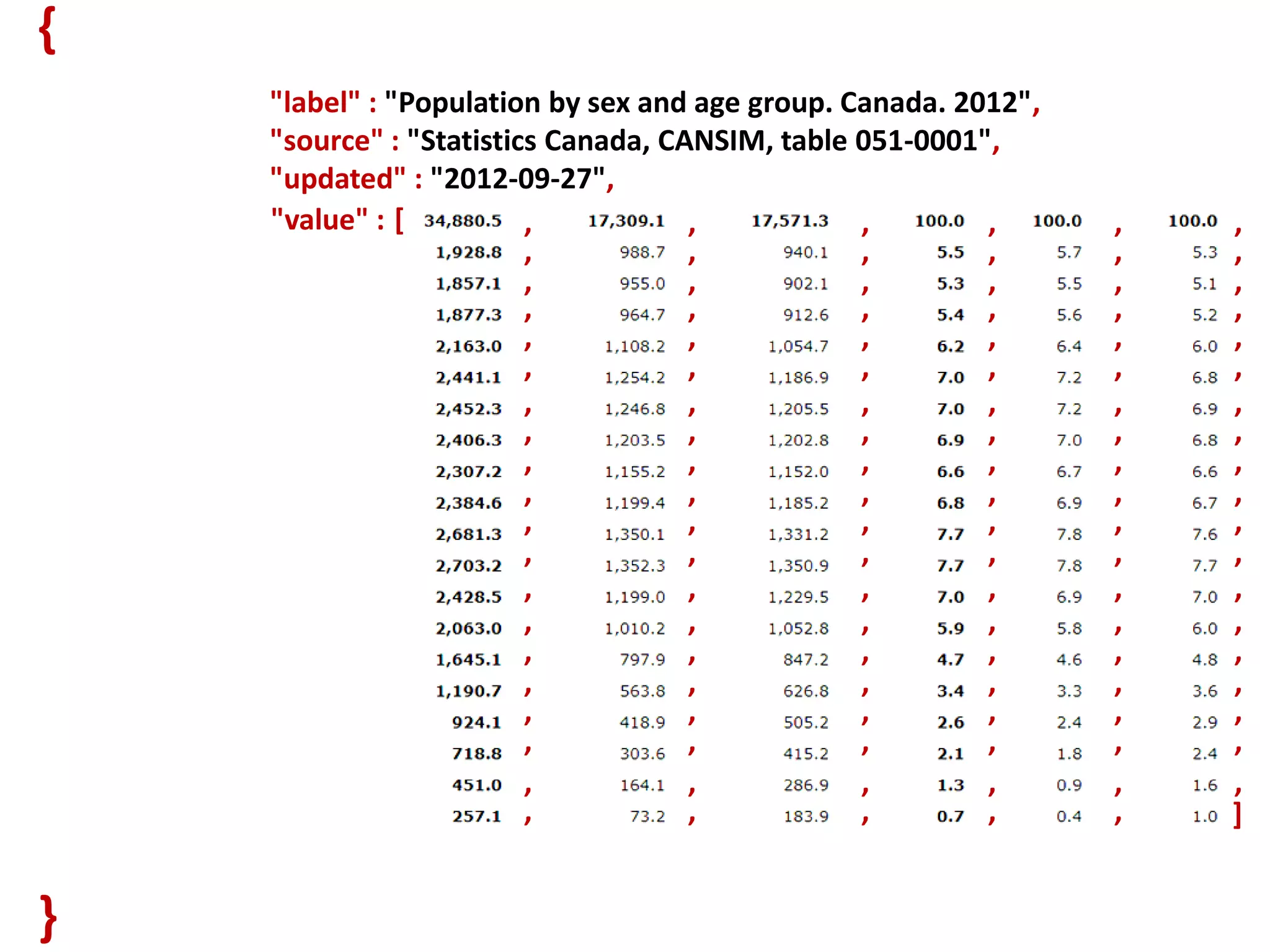
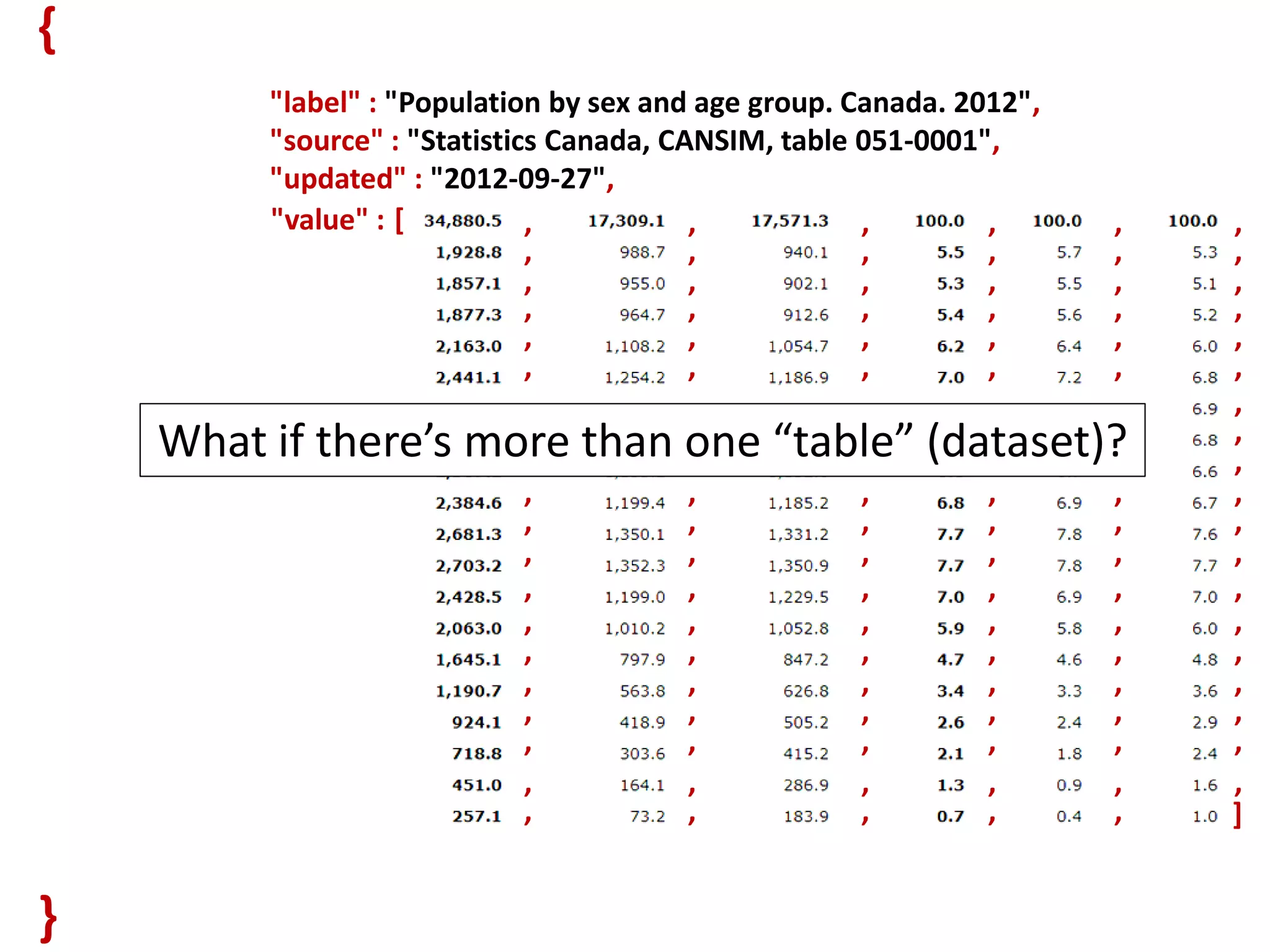
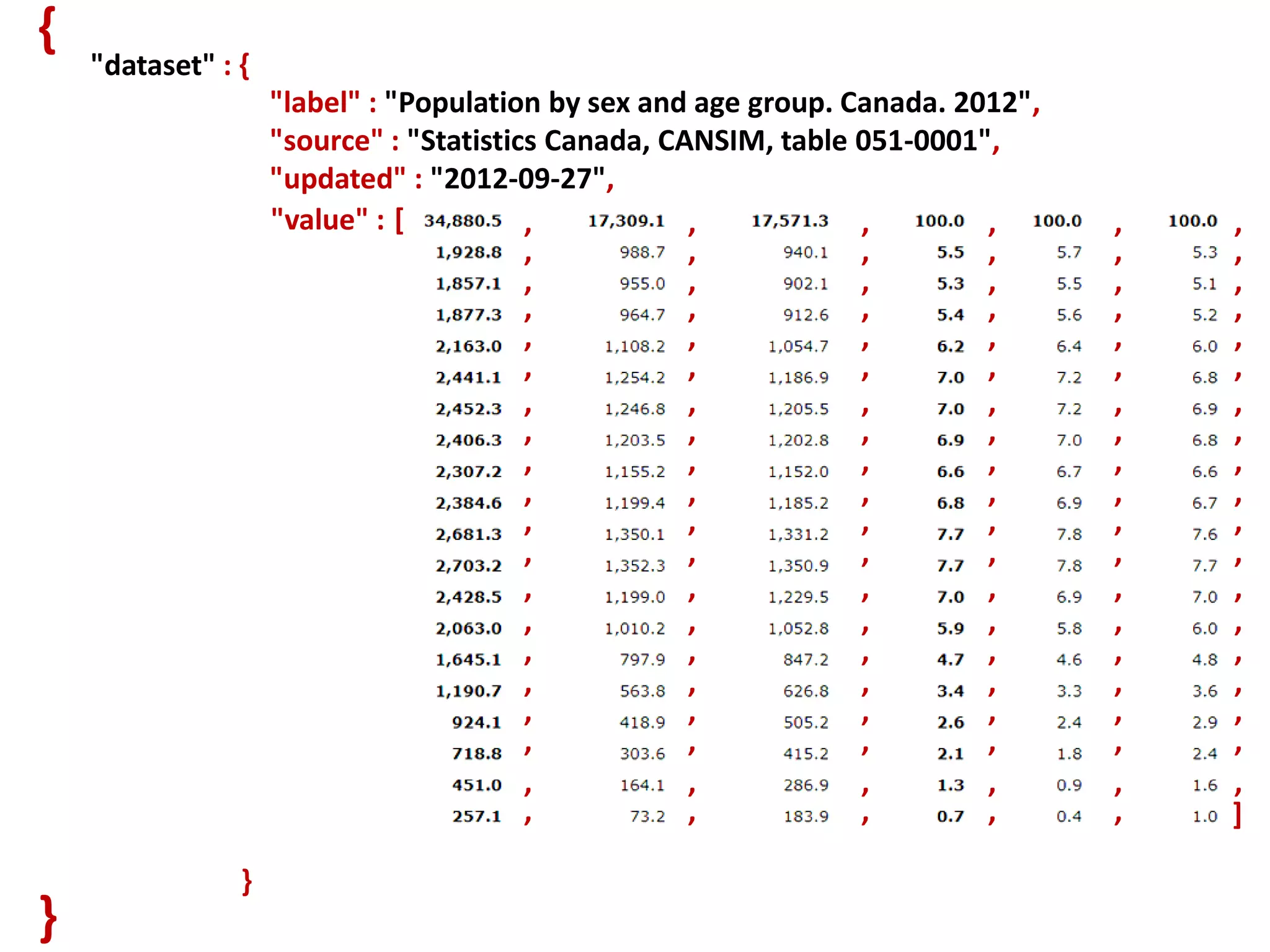
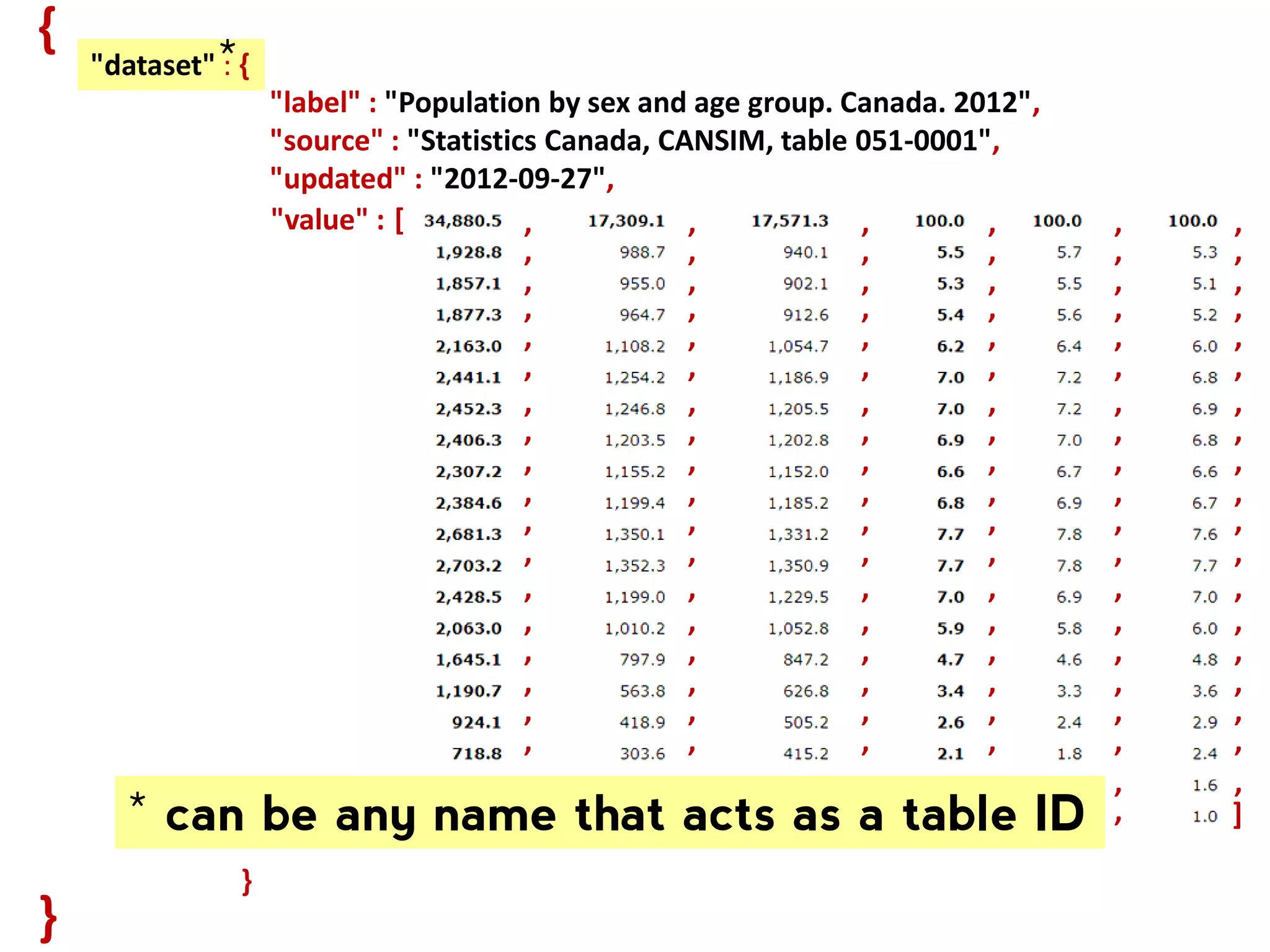
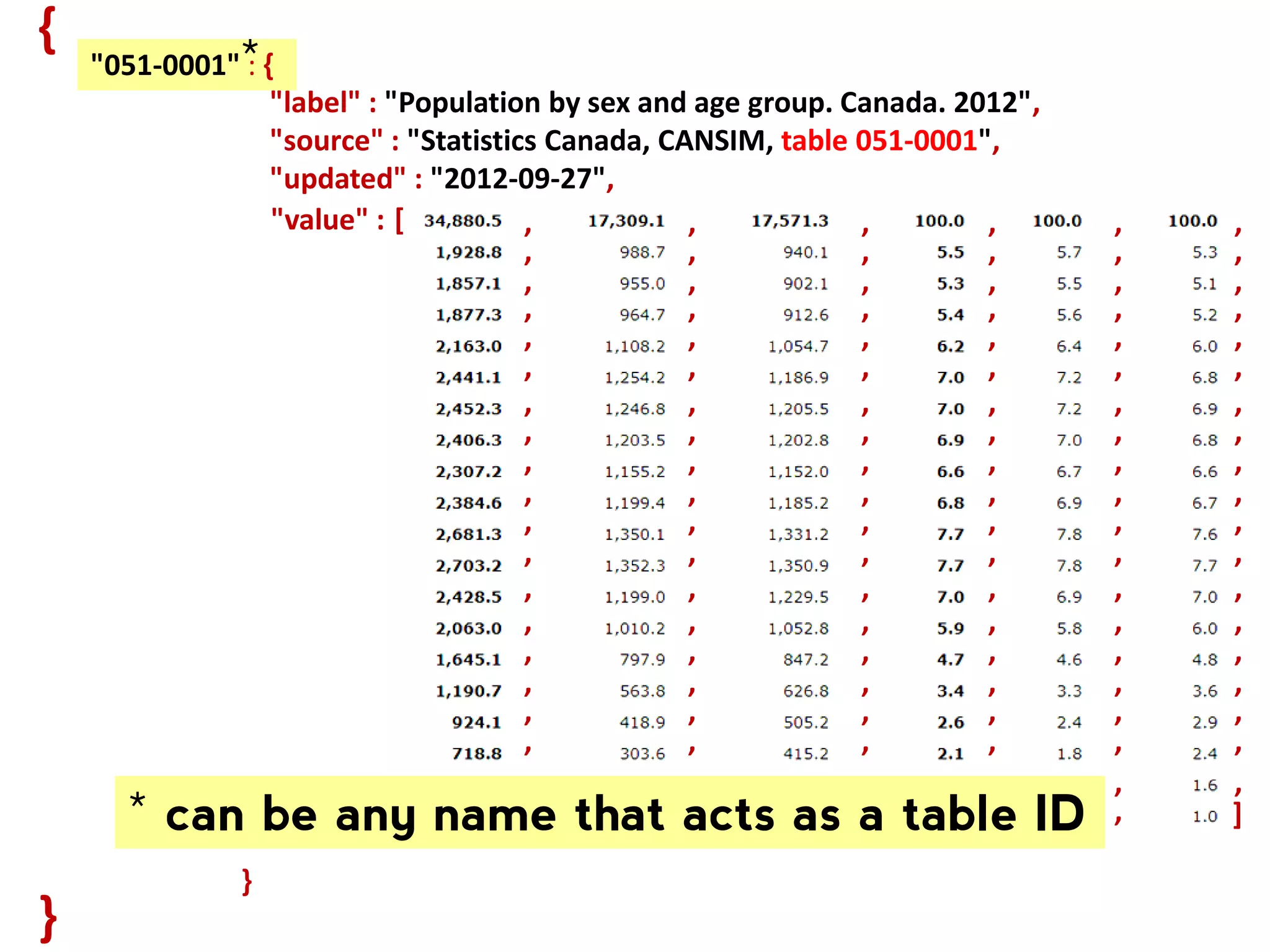
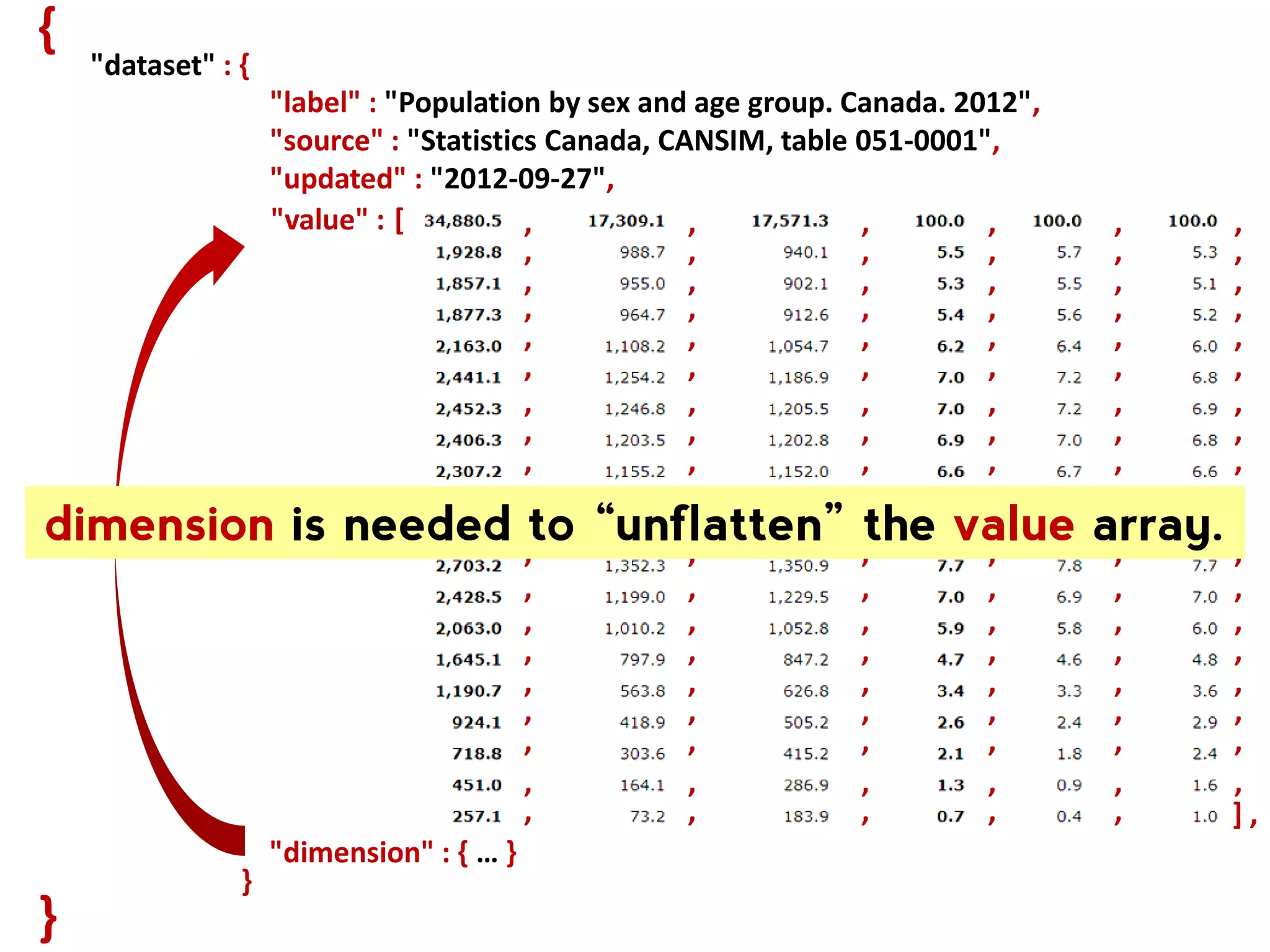
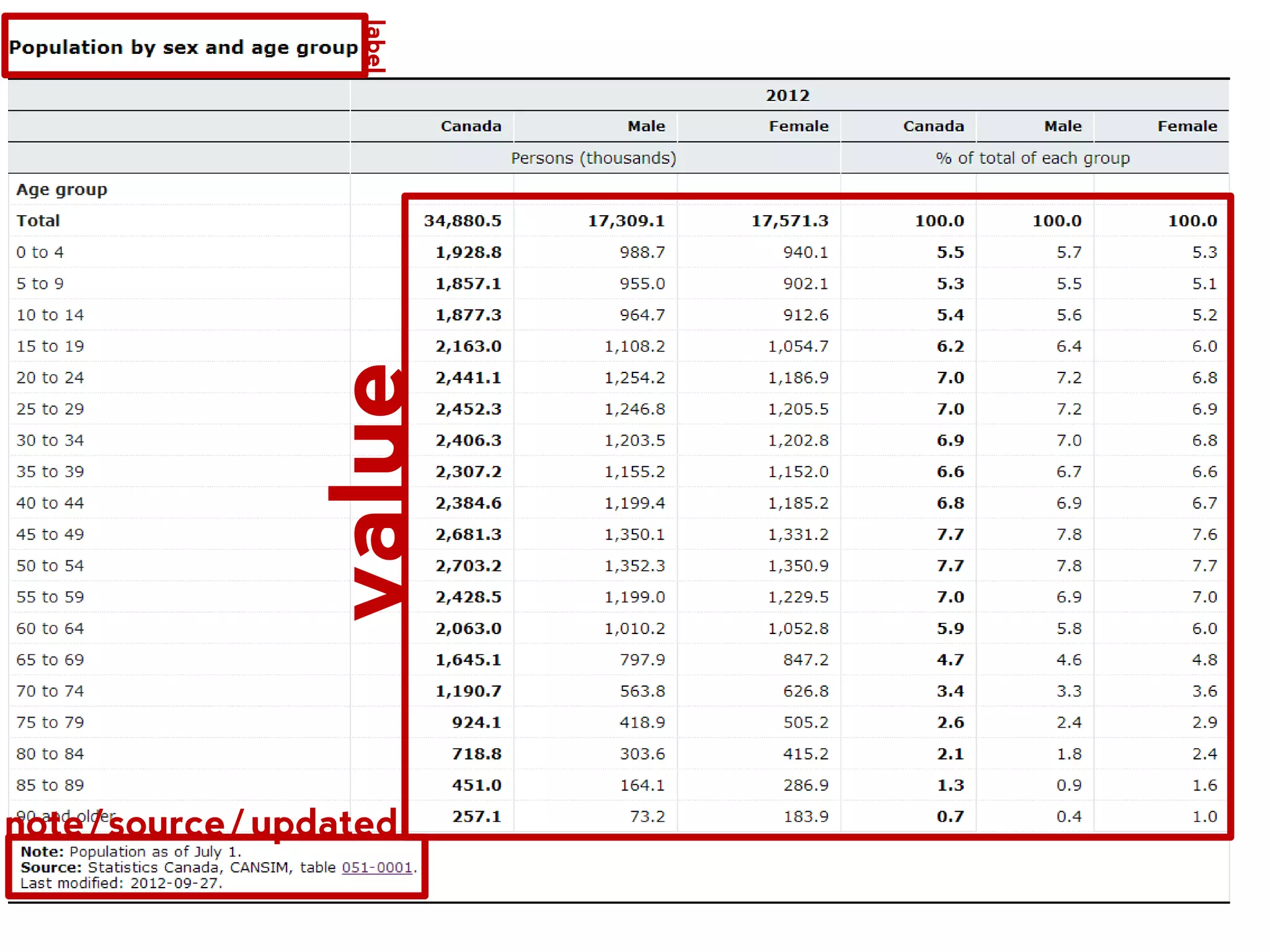
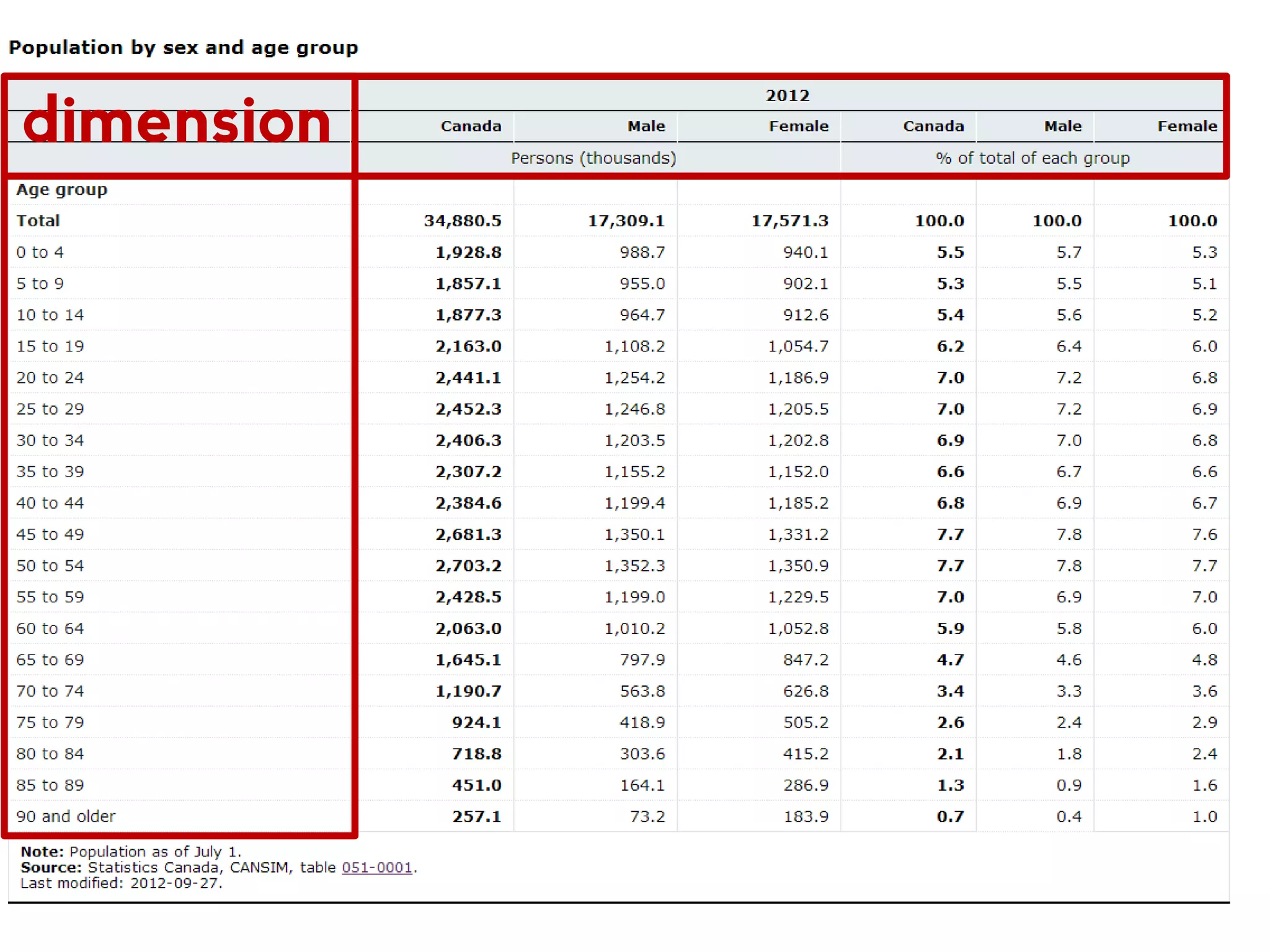
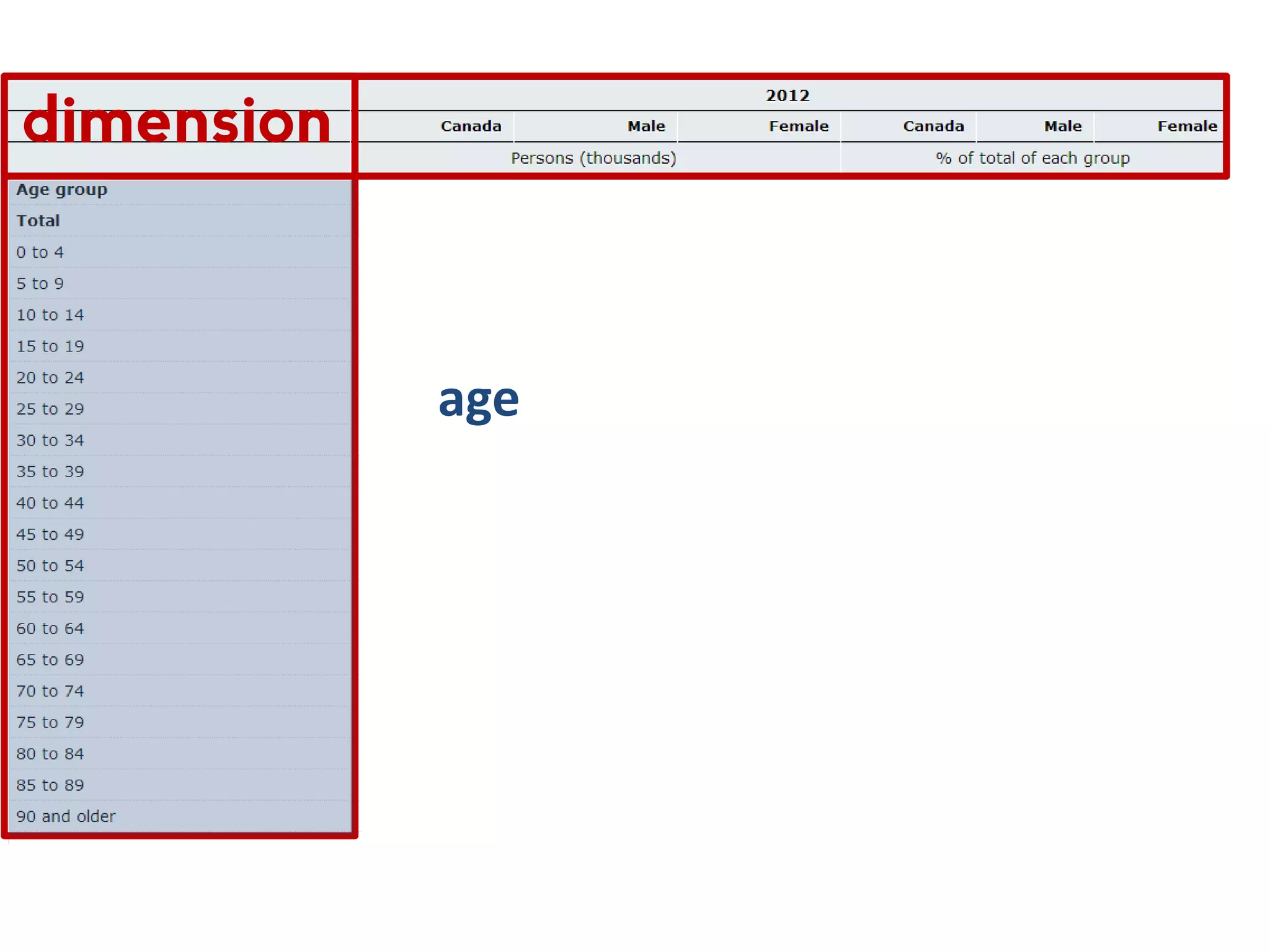
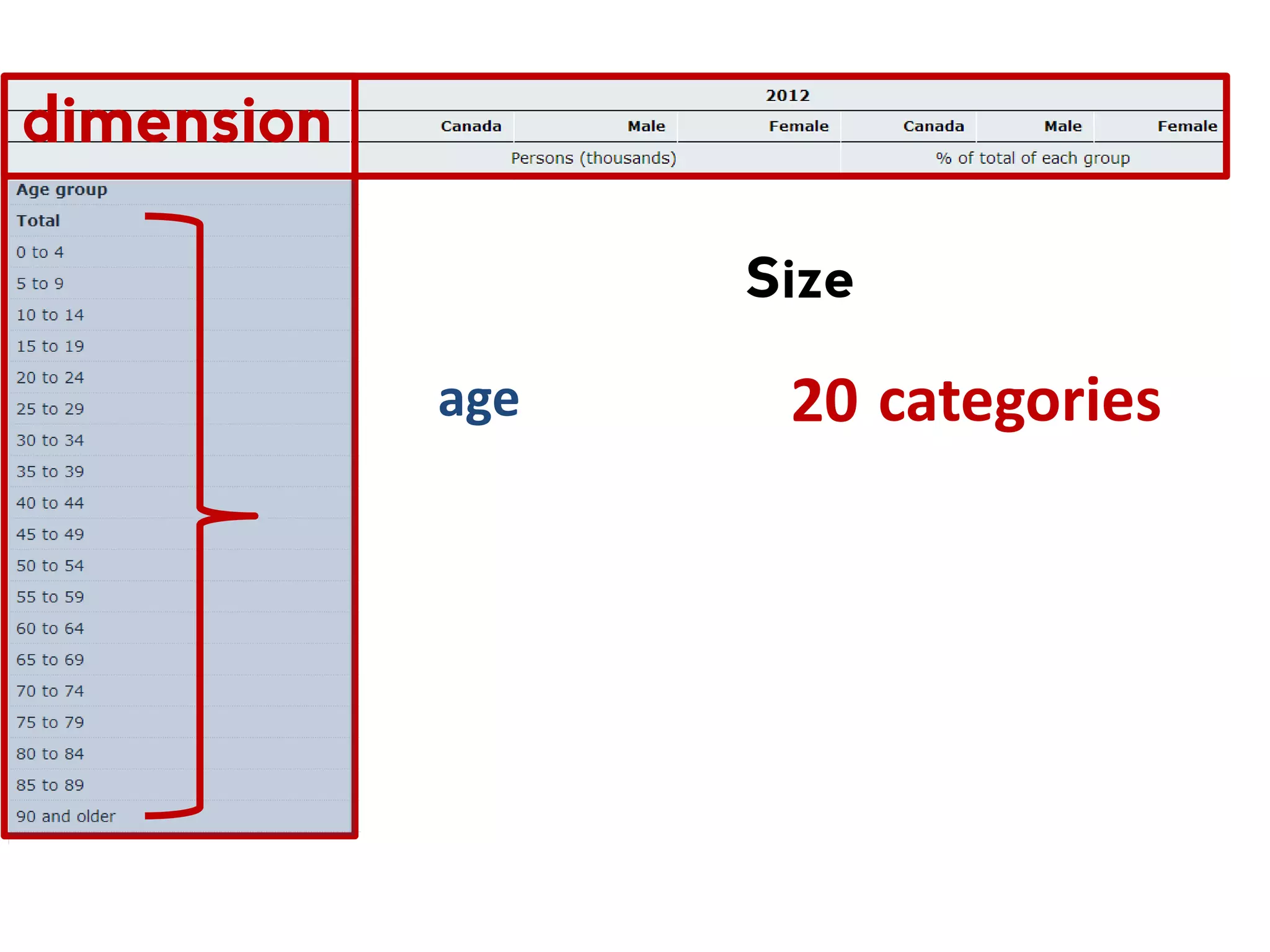
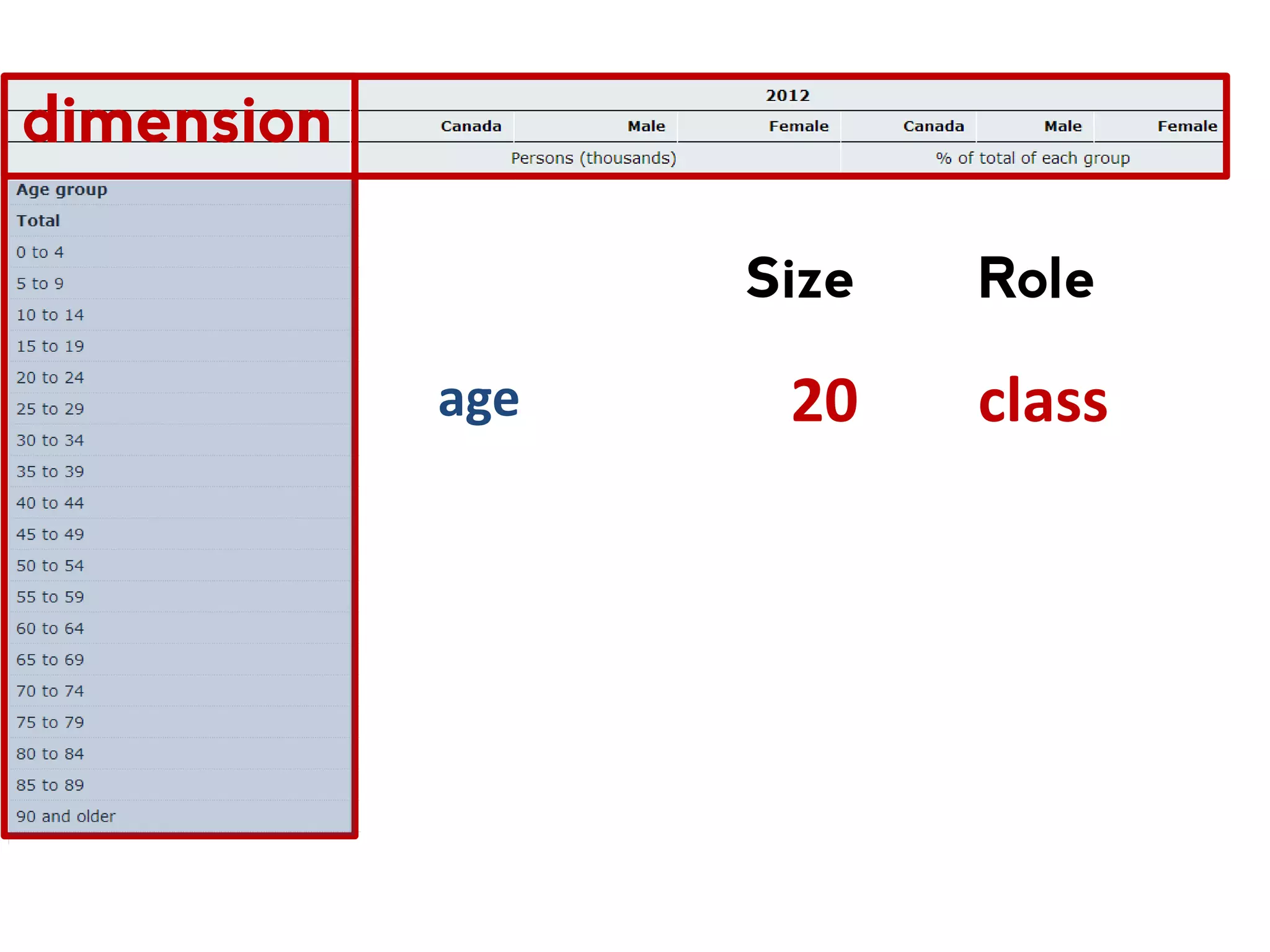
![[ ] , , , , , , , , , , , , , , , , , , , , , , , , , , , , , , , , , , , , , , , , , , , , , , , , , , , , , , , , , , , , , , , , , , , , , , , , , , , , , , , , , , , , , , , , , , , , , , , , , , , , , , , , , , , , , , , , , , , , , , To make sense of this array, dimensions must be ordered.](https://image.slidesharecdn.com/json-stat-130712002843-phpapp02/75/JSON-stat-a-simple-light-standard-for-all-kinds-of-data-disseminators-38-2048.jpg)
![[ ] , , , , , , , , , , , , , , , , , , , , , , , , , , , , , , , , , , , , , , , , , , , , , , , , , , , , , , , , , , , , , , , , , , , , , , , , , , , , , , , , , , , , , , , , , , , , , , , , , , , , , , , , , , , , , , , , , , , , , , ["country", "year", "age", "concept", "sex"] To make sense of this array, dimensions must be ordered.](https://image.slidesharecdn.com/json-stat-130712002843-phpapp02/75/JSON-stat-a-simple-light-standard-for-all-kinds-of-data-disseminators-39-2048.jpg)
![["country", "year", "age", "concept", "sex"] Criterion: What does not change, first. To make sense of this array, dimensions must be ordered. (Position of dimensions of size 1 is irrelevant.)](https://image.slidesharecdn.com/json-stat-130712002843-phpapp02/75/JSON-stat-a-simple-light-standard-for-all-kinds-of-data-disseminators-40-2048.jpg)
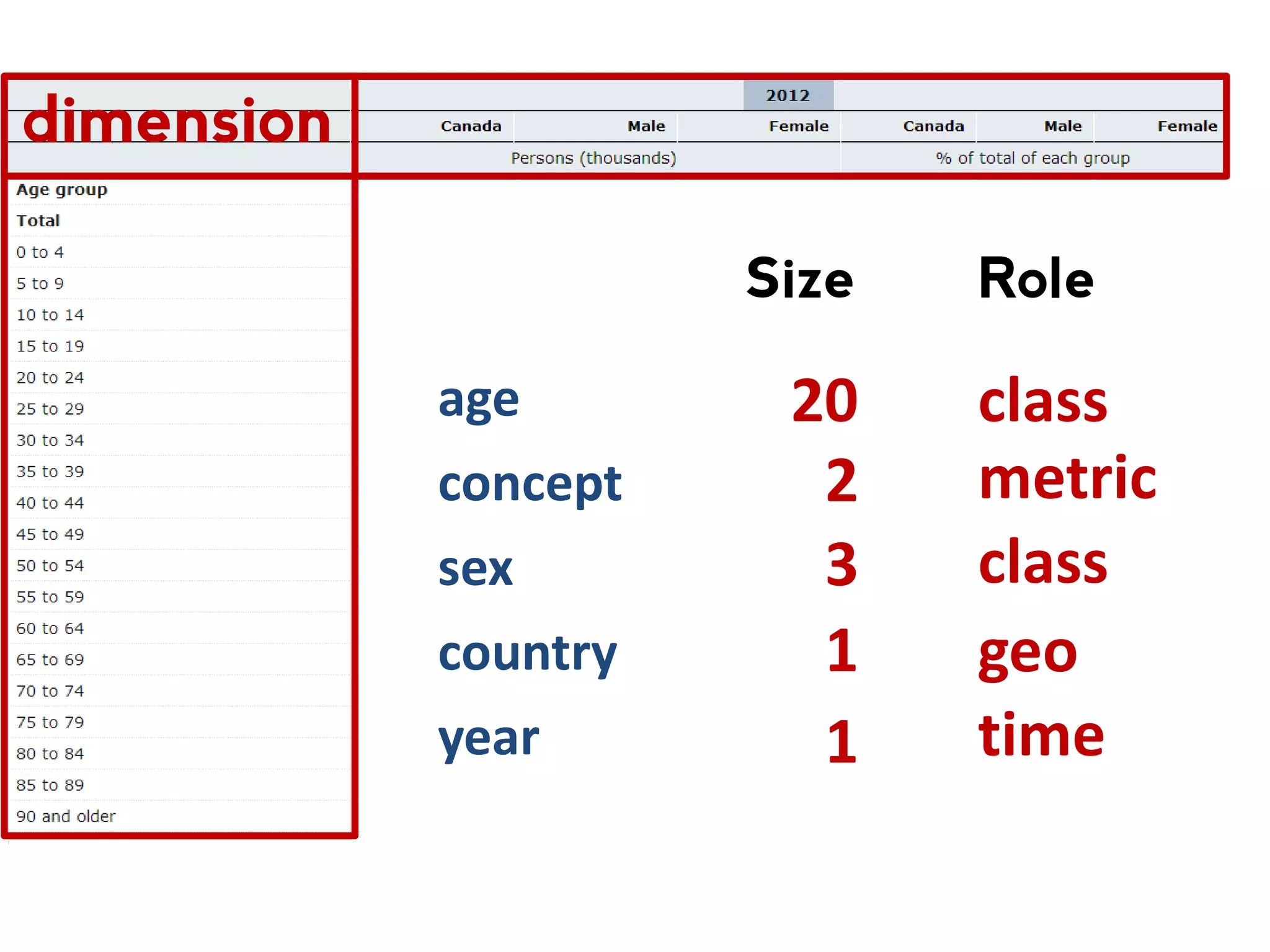
!["value" : [ … ] } { "version" : "2.0", "class" : "dataset", "label" : "Population by sex and age group. Canada. 2012", "source" : "Statistics Canada, CANSIM, table 051-0001", "updated" : "2012-09-27", "id" : [ "country" , "year" , "age" , "concept" , "sex" ], "size" : [ 1 , 1 , 20 , 2 , 3 ], "role" : { "time" : ["year"] , "geo" : ["country"] , "metric" : ["concept"] }, "dimension" : { … }](https://image.slidesharecdn.com/json-stat-130712002843-phpapp02/75/JSON-stat-a-simple-light-standard-for-all-kinds-of-data-disseminators-42-2048.jpg)
!["value" : [ … ] } { "id" : [ "country" , "year" , "age" , "concept" , "sex" ], "size" : [ 1 , 1 , 20 , 2 , 3 ], "role" : { "time" : ["year"] , "geo" : ["country"] , "metric" : ["concept"] }, "dimension" : { "country" : { … }, "year" : { … }, "age" : { … }, "concept" : { … }, "sex" : { … } } "version" : "2.0", "class" : "dataset", "label" : "Population by sex and age group. Canada. 2012", "source" : "Statistics Canada, CANSIM, table 051-0001", "updated" : "2012-09-27",](https://image.slidesharecdn.com/json-stat-130712002843-phpapp02/75/JSON-stat-a-simple-light-standard-for-all-kinds-of-data-disseminators-43-2048.jpg)
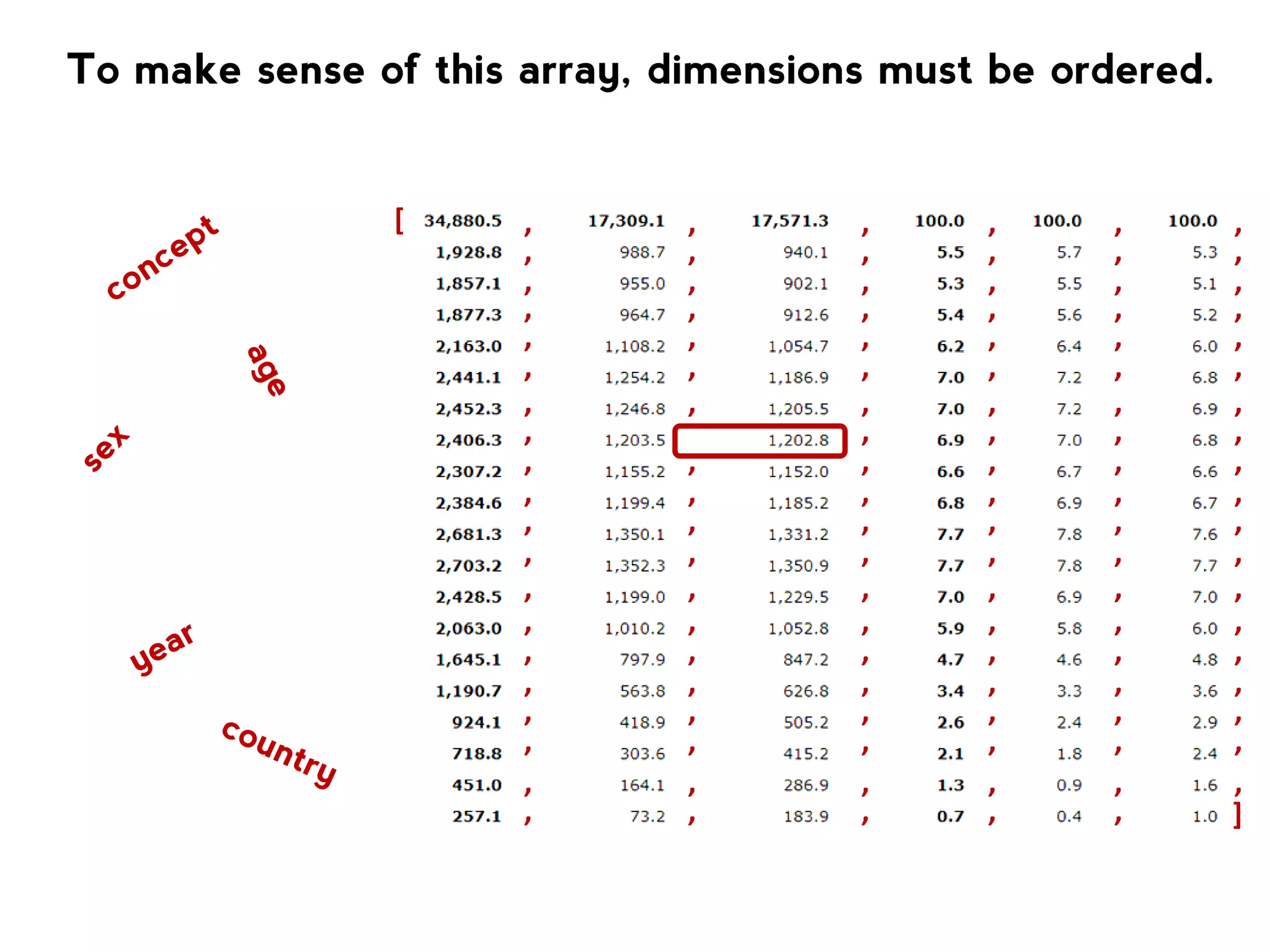
!["value" : [ … ] } { "id" : [ "country" , "year" , "age" , "concept" , "sex" ], "size" : [ 1 , 1 , 20 , 2 , 3 ], "role" : { "time" : ["year"] , "geo" : ["country"] , "metric" : ["concept"] }, "dimension" : { "country" : { … }, "year" : { … }, "age" : { … }, "concept" : { … }, "sex" : { … } } "version" : "2.0", "class" : "dataset", "label" : "Population by sex and age group. Canada. 2012", "source" : "Statistics Canada, CANSIM, table 051-0001", "updated" : "2012-09-27",](https://image.slidesharecdn.com/json-stat-130712002843-phpapp02/75/JSON-stat-a-simple-light-standard-for-all-kinds-of-data-disseminators-45-2048.jpg)
!["sex" : { "label" : "sex", "category" : { "index" : ["T", "M", "F"], "label" : { "T" : "Total", "M" : "Male", "F" : "Female" } } }](https://image.slidesharecdn.com/json-stat-130712002843-phpapp02/75/JSON-stat-a-simple-light-standard-for-all-kinds-of-data-disseminators-46-2048.jpg)
!["sex" : { "label" : "sex", "category" : { "index" : ["T", "M", "F"], "label" : { "T" : "Total", "M" : "Male", "F" : "Female" } } } {"T" : 0, "M" : 1, "F" : 2}, Also accepted (faster access)* * See “Arrays vs. Objects” http://bl.ocks.org/5708161](https://image.slidesharecdn.com/json-stat-130712002843-phpapp02/75/JSON-stat-a-simple-light-standard-for-all-kinds-of-data-disseminators-47-2048.jpg)
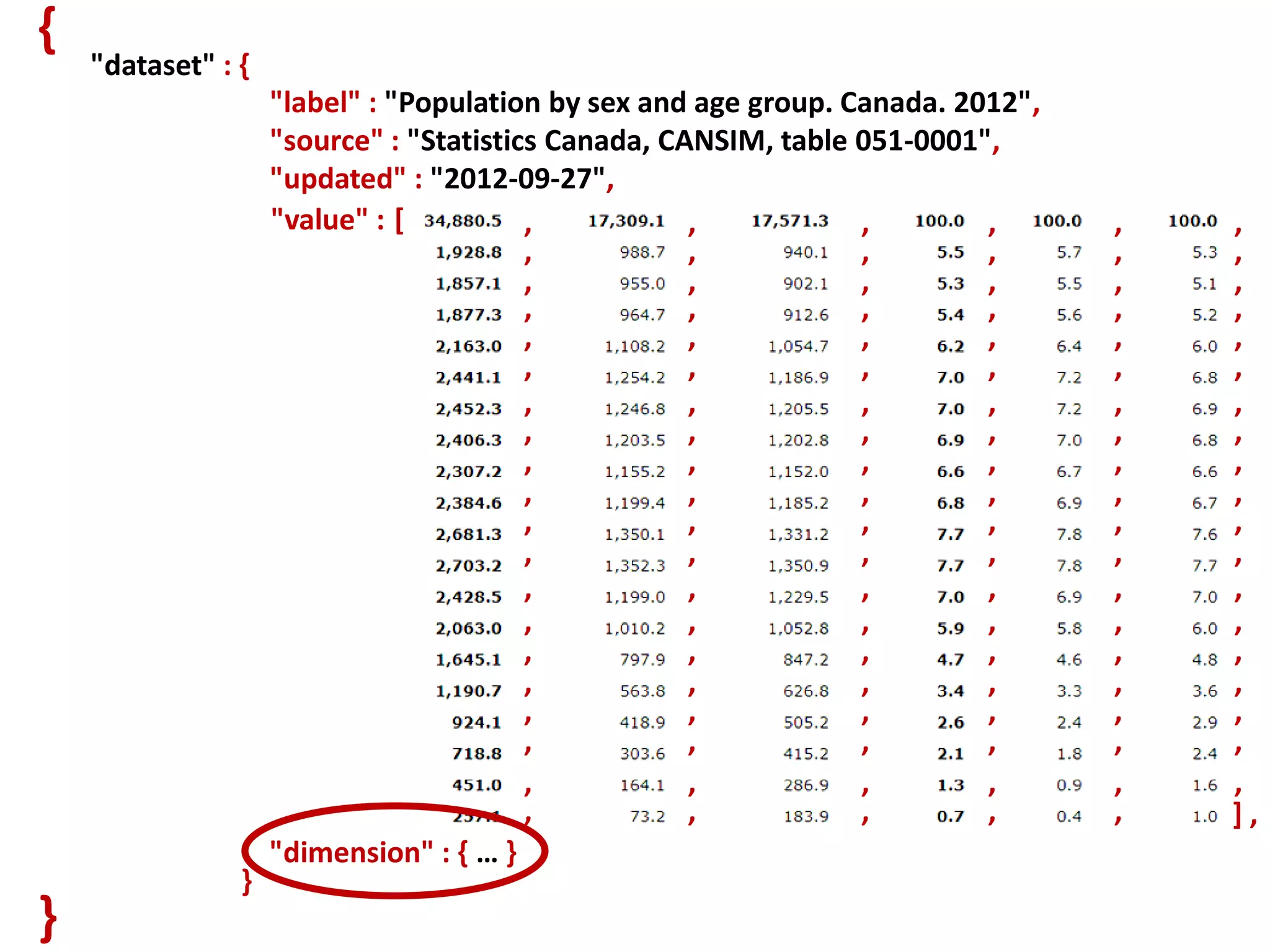
![The “unflattening” problem from dimension positions [0,0,7,0,2]](https://image.slidesharecdn.com/json-stat-130712002843-phpapp02/75/JSON-stat-a-simple-light-standard-for-all-kinds-of-data-disseminators-49-2048.jpg)
![The “unflattening” problem from dimension positions to value position 44[0,0,7,0,2]](https://image.slidesharecdn.com/json-stat-130712002843-phpapp02/75/JSON-stat-a-simple-light-standard-for-all-kinds-of-data-disseminators-50-2048.jpg)
![[ ] , , , , , , , , , , , , , , , , , , , , , , , , , , , , , , , , , , , , , , , , , , , , , , , , , , , , , , , , , , , , , , , , , , , , , , , , , , , , , , , , , , , , , , , , , , , , , , , , , , , , , , , , , , , , , , , , , , , , , , ["country", "year", "age", "concept", "sex"]](https://image.slidesharecdn.com/json-stat-130712002843-phpapp02/75/JSON-stat-a-simple-light-standard-for-all-kinds-of-data-disseminators-51-2048.jpg)
![[ ] , , , , , , , , , , , , , , , , , , , , , , , , , , , , , , , , , , , , , , , , , , , , , , , , , , , , , , , , , , , , , , , , , , , , , , , , , , , , , , , , , , , , , , , , , , , , , , , , , , , , , , , , , , , , , , , , , , , , , , ["country", "year", "age", "concept", "sex"] 0 1 2 3 4 5… 44 …120](https://image.slidesharecdn.com/json-stat-130712002843-phpapp02/75/JSON-stat-a-simple-light-standard-for-all-kinds-of-data-disseminators-52-2048.jpg)
![Persons (thousands) 2012 Canada ["country", "year", "age", "concept", "sex"] 0 0 0 is the first position (first category of the dimension)](https://image.slidesharecdn.com/json-stat-130712002843-phpapp02/75/JSON-stat-a-simple-light-standard-for-all-kinds-of-data-disseminators-53-2048.jpg)
![Persons (thousands) 2012 Canada ["country", "year", "age", "concept", "sex"] 0 0 0 1 2 3 4 5 6 7](https://image.slidesharecdn.com/json-stat-130712002843-phpapp02/75/JSON-stat-a-simple-light-standard-for-all-kinds-of-data-disseminators-54-2048.jpg)
![Persons (thousands) 2012 Canada ["country", "year", "age", "concept", "sex"] 0 0 0 1 0](https://image.slidesharecdn.com/json-stat-130712002843-phpapp02/75/JSON-stat-a-simple-light-standard-for-all-kinds-of-data-disseminators-55-2048.jpg)
![Persons (thousands) 2012 Canada ["country", "year", "age", "concept", "sex"] 0 0 0 0 1 2](https://image.slidesharecdn.com/json-stat-130712002843-phpapp02/75/JSON-stat-a-simple-light-standard-for-all-kinds-of-data-disseminators-56-2048.jpg)
![Persons (thousands) 2012 Canada ["country", "year", "age", "concept", "sex"] 0 0 0 [0, 0, 7, 0, 2] → 44](https://image.slidesharecdn.com/json-stat-130712002843-phpapp02/75/JSON-stat-a-simple-light-standard-for-all-kinds-of-data-disseminators-57-2048.jpg)
![2012 Canada ["country", "year", "age", "concept", "sex"] 0 0 0 [ 1, 1, 20, 2, 3 ] Persons (thousands) (Size) [0, 0, 7, 0, 2] → 44](https://image.slidesharecdn.com/json-stat-130712002843-phpapp02/75/JSON-stat-a-simple-light-standard-for-all-kinds-of-data-disseminators-58-2048.jpg)
![The“unflattening” problem ["country", "year", "age", "concept", "sex"] [ 1, 1, 20, 2, 3 ] [0, 0, 7, 0, 2] → 44](https://image.slidesharecdn.com/json-stat-130712002843-phpapp02/75/JSON-stat-a-simple-light-standard-for-all-kinds-of-data-disseminators-59-2048.jpg)
![The“unflattening” problem ["country", "year", "age", "concept", "sex"] [ 1, 1, 20, 2, 3 ] It’s a simple mathematical problem Compute value position using dimension position & size [0, 0, 7, 0, 2] → 44](https://image.slidesharecdn.com/json-stat-130712002843-phpapp02/75/JSON-stat-a-simple-light-standard-for-all-kinds-of-data-disseminators-60-2048.jpg)
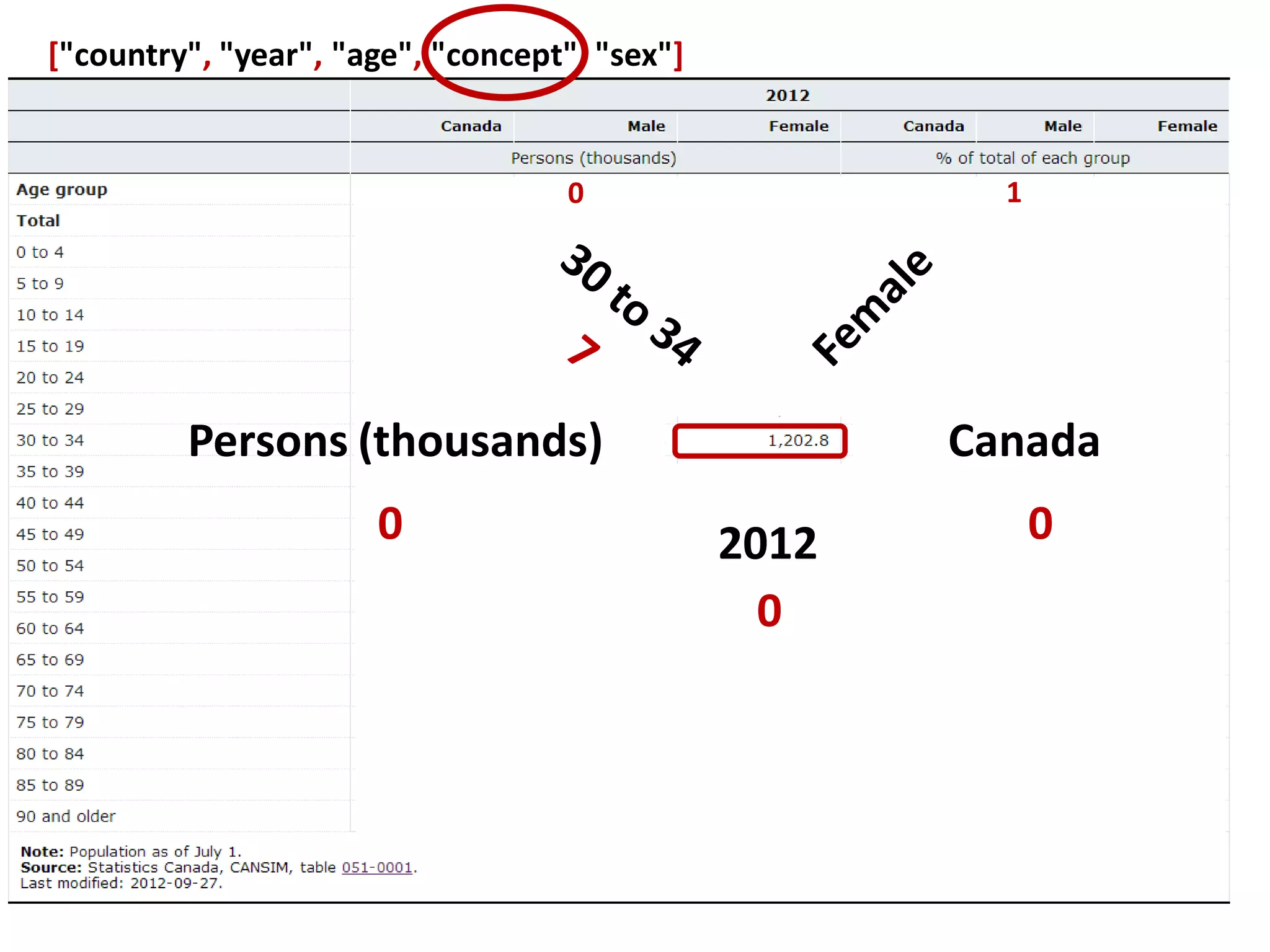
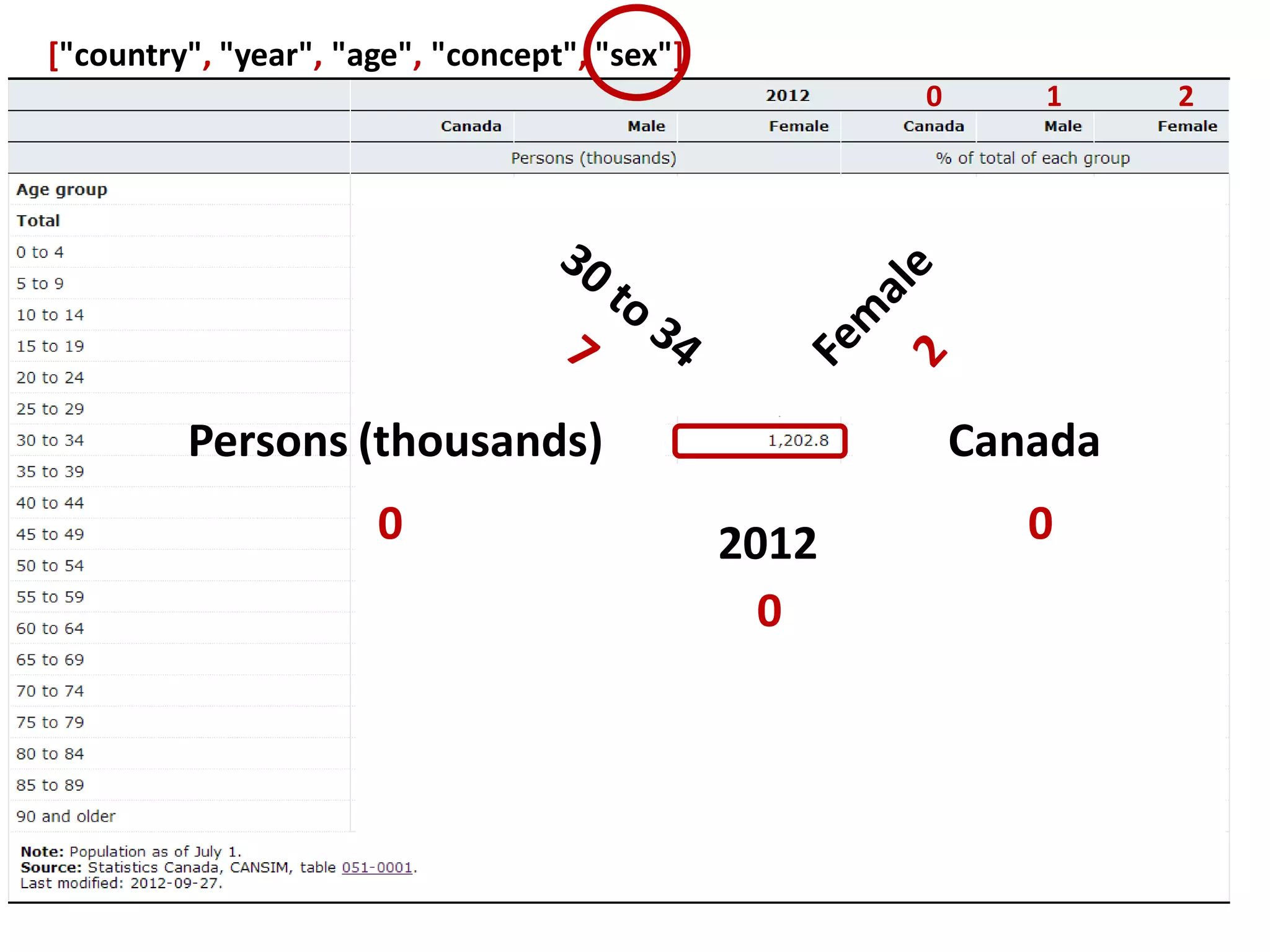
![Lost in cells? Are you a coder? Do you want to develop your own library? arr2num( [0,0,7,0,2], [1,1,20,2,3] ) 44](https://image.slidesharecdn.com/json-stat-130712002843-phpapp02/75/JSON-stat-a-simple-light-standard-for-all-kinds-of-data-disseminators-63-2048.jpg)
![Lost in cells? Here’s a simple solution to the “unflattening” problem. function arr2num( arr, size ){ for(var i=0, num=0, mult=1, ndims=size.length; i<ndims; i++){ mult*=(i>0) ? size[ndims-i] : 1; num+=mult*arr[ndims-i-1]; } return num; } arr2num( [0,0,7,0,2], [1,1,20,2,3] ) 44](https://image.slidesharecdn.com/json-stat-130712002843-phpapp02/75/JSON-stat-a-simple-light-standard-for-all-kinds-of-data-disseminators-64-2048.jpg)
![Lost in cells? Or check the sample code section at http://json-stat.org/tools/ function arr2num( arr, size ){ for(var i=0, num=0, mult=1, ndims=size.length; i<ndims; i++){ mult*=(i>0) ? size[ndims-i] : 1; num+=mult*arr[ndims-i-1]; } return num; }](https://image.slidesharecdn.com/json-stat-130712002843-phpapp02/75/JSON-stat-a-simple-light-standard-for-all-kinds-of-data-disseminators-65-2048.jpg)
